















































































































































































































































































































































































































































































































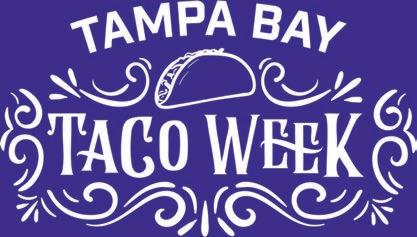
$ 8 . 9 9
$8.99

















2 cr c ispy co c rn stea e k, onion, cilantro, co c rn, sprinkled e with t cot o ij i a cheese drizzled with our zes e ty corn o B u s L o c a t i o n s 2 S




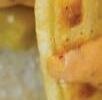

















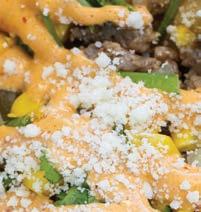













































2crispycorn tortillas steak,onion, cilantro,corn, sprinkledwith cotijacheese and drizzledwith ourzestycorn sauce
o
PUBLISHER James Howard
Editorial
MANAGING EDITOR Selene San Felice
FILM & TV CRITIC John W. Allman
IN-HOUSE WITCH Caroline DeBruhl
CONTRIBUTORS Josh Bradley, Linda Saul-Sena, Sofía García Vargas, David Warner
PHOTOGRAPHERS Dave Decker, Linda Saul-Sena POLITICAL CARTOONIST Bob Whitmore
SPRING INTERN Grace Stoler (apply for fall by emailing clips and a resume to rroa@cltampa.com)
Creative Services
CREATIVE DIRECTOR Jack Spatafora
ILLUSTRATORS Dan Perkins, Cory Robinson
Advertising
SENIOR ACCOUNT EXECUTIVE Anthony Carbone
Events and Marketing
MARKETING, PROMOTIONS AND EVENTS DIRECTOR Leigh Wilson
MARKETING, PROMOTIONS AND EVENTS COORDINATOR Kristin Bowman
Circulation
CIRCULATION MANAGER Ted Modesta
Chava Communications Group
FOUNDER, CHIEF EXECUTIVE OFFICER
Michael Wagner
CO-FOUNDER, CHIEF MARKETING OFFICER
Cassandra Yardeni Wagner
CHIEF OPERATING OFFICER Graham Jarrett
VP OF OPERATIONS Hollie Mahadeo
DIRECTOR OF AGENCY SERVICES
Kelsey Molina
SOCIAL MEDIA DIRECTOR Meradith Garcia
ART DIRECTOR David Loyola
DIGITAL OPERATIONS COORDINATOR Jaime Monzon chavagroup.com cltampabay.com cldeals.com
EDITORIAL POLICY — Creative Loafing Tampa Bay is a publication covering public issues, the arts and entertainment. In our pages appear views from across the political and social spectrum. They do not necessarily represent the views of the publisher.
Creative Loafing Tampa is published by Tampa Events & Media, LLC, 633 N Franklin St., Suite 735. Tampa, Florida, 33602.
The physical edition is available free of charge at locations throughout Tampa Bay and online at cltampabay.com. Copyright 2023, Tampa Events and Media, LLC.
The newspaper is produced and printed on Indigenous land belonging to Tampa Bay’s Tocobaga and Seminole tribes.
Our main number: (813) 739-4800
Letters to the editor: comments@cltampa.com
Anonymous news tips: cltampabay_tips@protonmail.com






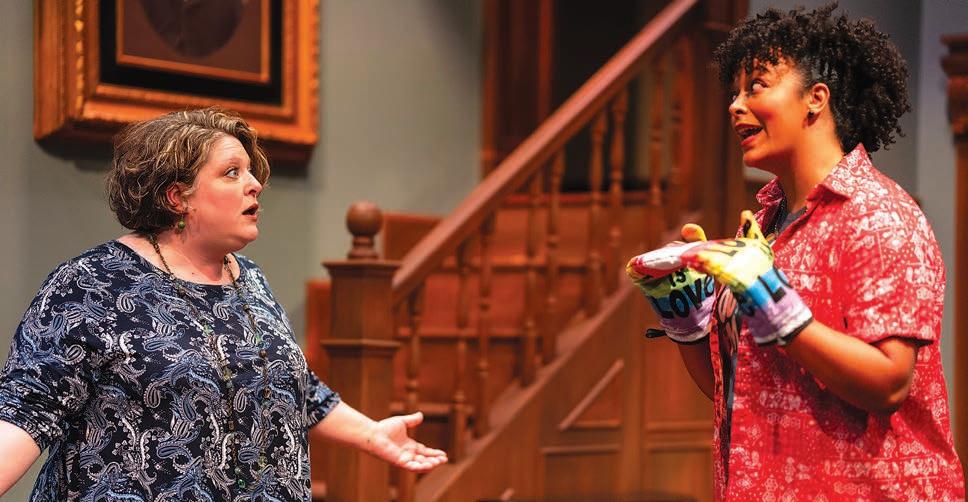
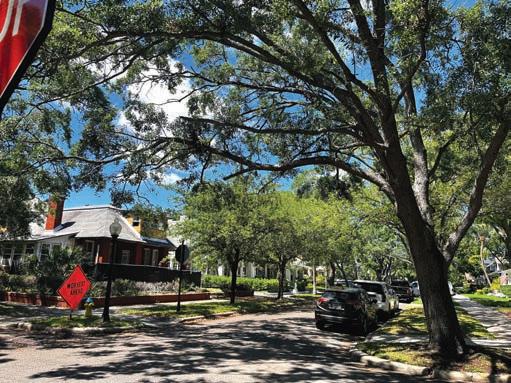
Follow us:
twitter.com/cl_tampabay instagram.com/cltampabay facebook.com/cltampabay





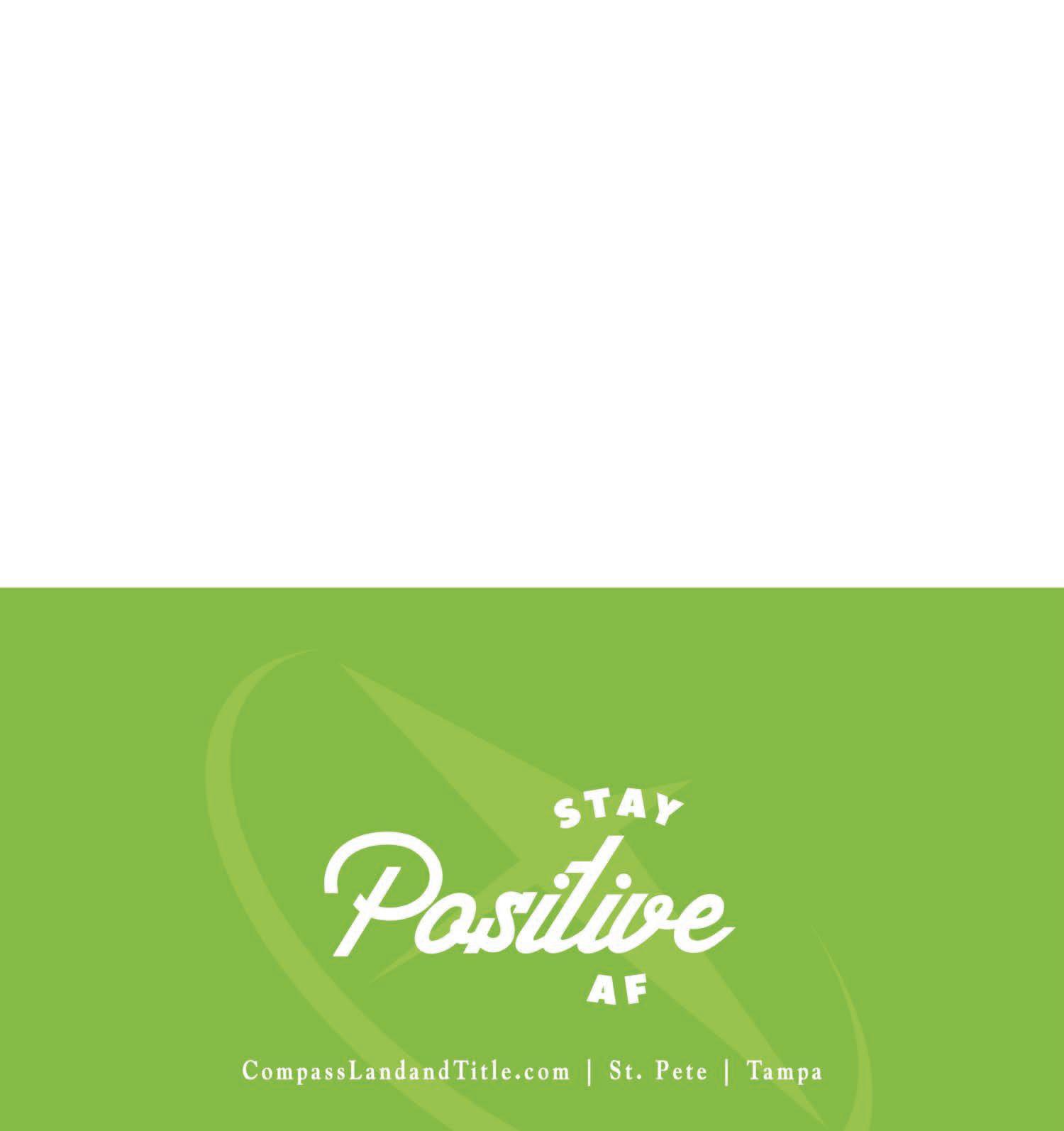




Casamigos, Estrella Galicia, and La Luna Mezcal present






























Los Chapos

Three “Birria tacos” and a “aqua fresca“ - $15






Marina Cantina
Blackened shrimp and steak, 2 flour tortillas, pico de gallo, salsa verde - $15
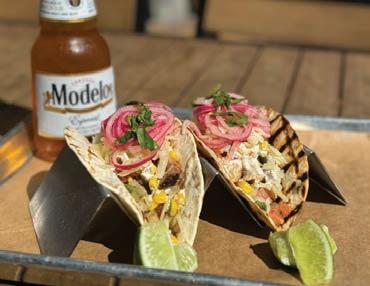


Choice of 2, Mix & Match - $14



jotoro
Slow braised Korean style BBQ beef, pepperjack cheese, diced onion, with spicy beef broth for dipping – $18

$5 margaritas all day during Taco Week!
Also, regular Dirty Hours specials: 2pm-6pm $8 tres tacos, $3 beer/seltzers



Filet Mignon Tacos: Bacon-onion jam, jack cheese, fried onions, tamarind aioli - $16
Handcrafted Margarita featuring Blanco Casamigos – $16

Fried Mahi-Mahi Taco w/ manchego cheese, pickled red onion, avocado crema & mango salsa
Smoked Chicken Taco w/ manchego cheese, pickled red onion, avocado crema & corn salsa
Smoked Pork Taco w/ manchego cheese, pickled red onion, avocado crema & corn salsa
Texas-style Brisket Taco w/ manchego cheese, pickled red onion, avocado crema & corn salsa
Two El Jefe Taco Selections with a choice of queso blanco or traditional guacamole - $15







2 for $16 – Mix or Match, Choice of:
Carne Asada Taco Grilled Cumin & Garlic Brined Tri-Tip Steak , Avocado, Chimichurri Sauce, Pickled Red Onions & Tomatillo Salsa on Grilled Flour Tortilla
Tempura Avocado Taco Fried Avocado, Pickled Red Onions, Queso Fresco & Blue Cheese Aioli on a Grilled Flour Tortilla
SPICY CUCUMBER JALAPEÑO MARGARITA- $15
Casamigos Blanco Tequila, Fresh Lime Juice, Simple Syrup, Cucumber &
























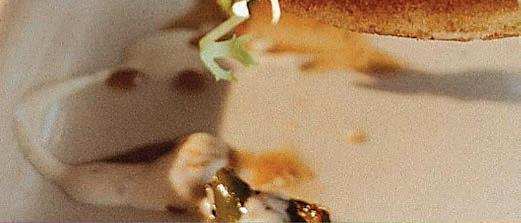
Enjoy fresh, chef-crafted meals by Chef Rosa, locally roasted coffee, and a variety of

and mainstream beers, wines, and ciders. Relax on our balcony with stunning Ybor views and discover incredible artwork from local artists.
Come for breakfast, lunch, or dinner — we can’t wait to serve you!
Hours of Operation: Mon-Thu 7am-8pm / Fri 7am-3pm / Sat-Sun 9am-3pm
Dr. Melissa Fickey is a highly respected adult and child psychiatrist dedicated to compassionate, innovative mental health care. As a leading practitioner at Embracing Life Wellness Center, she provides expert psychiatric services at the center’s Tampa and Riverview, FL locations. With a patient-centered approach, Dr. Fickey tailors treatment plans to each individual’s unique needs.
Dr. Fickey specializes in treating a wide range of mental health conditions, offering integrative, evidence-based solutions that include cutting-edge treatments like NeuroStar TMS Therapy.
navigate challenges. She works closely with families to develop effective treatment strategies that support long-term well-being.
Dr. Fickey also focuses on women’s mental health, addressing conditions such as mental health challenges. She understands the unique psychological and physiological factors affecting women and tailors treatments accordingly.


A highlight of the center’s offerings, NeuroStar Transcranial Magnetic Stimulation (TMS) is a non-invasive, FDA-cleared treatment for individuals struggling with treatment-resistant depression. Using magnetic pulses to stimulate underactive brain areas, TMS offers a medicationfree alternative with minimal side effects.
Recognizing the importance of early intervention, Dr. Fickey specializes in child and adolescent psychiatry, helping young patients


Beyond clinical care, Dr. Fickey is passionate about mental health advocacy, education, and stigma reduction. Through community outreach and educational initiatives, she empowers individuals to seek help and fosters a more supportive society.
For expert psychiatric care, visit Embracing Life Wellness Center in Tampa or Riverview. Whether seeking care for yourself or a loved one, Dr. Fickey and her team are here to help.
Schedule an appointment today by visiting our website or calling the nearest location. Take the fi rst step toward better mental health and well-being!





Tampa Bay's best things to do from April 17 - 23

Drag queen Jewels Sparkles has made Tampa proud through the entire 17th season of RuPaul’s Drag Race. And next week she could shine even brighter for us with a crown and scepter. Sparkles and three other finalists—Lexi Love, Onya Nurve and Sam Star—will compete for the crown and $200,000 in Friday’s episode. Cocktail St. Pete and Southern Nights Tampa host watch parties each week. Drag Race alum Latrice Royale hosts this week at Cocktail, and Gia Banks hosts the Southern Nights celebration. The show starts at 8 p.m. Friday, but be sure to get there in time to grab a drink and a good viewing spot. Though the finale is pre-recorded, Jewels will be watching with the other finalists. Multiple queens are filmed being crowned to prevent finale attendees from leaking the results, so they see the winner on TV along with the rest of us. Visit cltampa. com/arts for more details.
‘RuPaul’s Drag Race/ Finale watch parties: Friday, April 18. 8pm. No cover. Cocktail, 2355 Central Ave, St. Petersburg. Southern Nights, 1401 E 7th Ave, Tampa—Selene San Felice

The Pier 60 Sugar Sand Festival started last weekend, but now the pesky spring breakers are out of the way. Seventeen pro sand sculptors have turned 24,000 square feet of Clearwater Beach into a sandy land before time for the theme “Dinoshores— A Prehistoric Adventure in Sand.” If that’s not trippy enough, the festival now has augmented reality and projection mapping to make the sandy ‘saurs stomp, roar and roam before your eyes.
Pier 60 Sugar Sand Festival: April 11-27. 10 a.m.-9 p.m. $14 & up. 1 Causeway Blvd, Clearwater Beach. sugarsandfestival.com—Selene San Felice

There are 80 stops on its Red Bull Dance Your Style qualifier circuits, where competitors play to crowds who’ll send them to the national finals happening this summer in San Francisco. The catch is that dancers don’t know which song they’ll draw, forcing them to come up with routines on the spot. After popping up at Sparkman Wharf and Ybor City’s Cuban Club in past year’s this year’s edition finds Red Bull back in South Tampa Heights for the high-energy event.
Red Bull Dance Your Style: Saturday, April 19. 7 p.m. $5. 1910 N Ola Ave., Tampa. armatureworks.com—Ray Roa
of the times
It’s been a riveting time for architecture buffs and people who enjoyed “The Brutalist,” thanks to Tampa Bay Design week, which wraps this weekend after spending the last six days showing off the area’s historic and unique structures. The Water Street walking tour on Thursday, April 17 is sold-out, likely because it included rooftop drinks at Tampa Edition, but Friday’s Tampa Urban Riverboat Tour explores downtown’s waterfront through the lens of urban planning, architecture and sustainability. Urban designer Josh Frank and architect Ross Tisdale lead the tour on the Pirate Taxi to discuss the city’s urban evolution and waterfront revitalization. The last Tampa Bay Design Week happens Saturday, April 19, and brings to light Polk County’s most fascinating design spots starting at Florida Southern College’s Ashley Gibson Barnett Museum of Art (The AGB, known as the Polk Museum of Art). The tour moves to Winter Haven to see three properties by the renowned Sarasota-School Architect, Gene Leedy, FAIA.
Tampa Bay Design Week: through Saturday, April 19. Various venues and cover prices. cadtampabay.org—Selene San Felice

Sunken Gardens has two opportunities to celebrate Earth Day with scavenger hunts on Sunday and Tuesday. Visitors can explore its winding paths to learn about the plants, insects and animals that call the 4.1-acre botanical garden home. Winners can take home Florida wildflower seeds to celebrate the Earth year-round. See more Earth Day activities via cltampa.com/arts.
Earth Day Scavenger Hunt: Sunday, April 19. Noon-4:30 p.m. Tuesday April 22. 10 a.m.-4:30 p.m. $6-$15. Sunken Gardens, 1825 4th St. N, St. Petersburg. sunkengardens.org —Selene San Felice
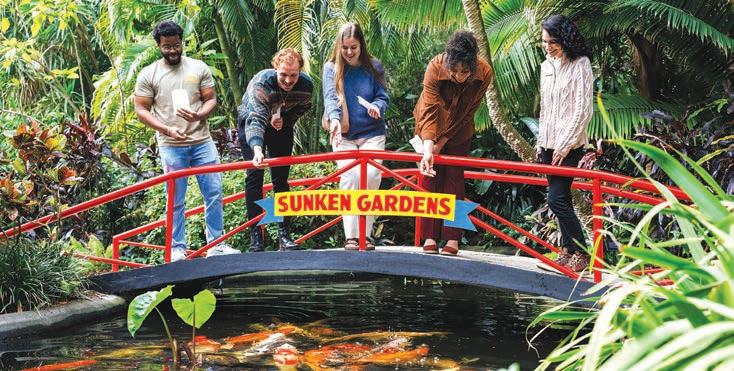
Becoming a blueberry
Plant City’s sweetest tradition is back. The Keel Farms Blueberry Festival started earlier this month, but for anyone thinking they blue it there’s still lots of time to go. The festival runs every weekend in April, except Easter Sunday. The fresh-made wines and ciders will be ready to pour, and the whole family can get in on u-pick berries (while they last). Come hungry for the blueberry shortcake eating contest. The farm, started on 10 Plant City acres in 1981 by Tampa landscaper Joe Keel, makes fresh beer, wine and cider for its Keel & Curley Winery and Keel Agrarian Ale + Cider. Joe’s son, Clay and his wife, Carmon, now run the farm hosting its famous blueberry festival and family-friendly events.
Blueberry Festival: April 19, 26, and 27. 10 a.m-3p.m. Keel Farms, 5202 Thonotosassa Rd., Plant City. keelfarms.com/festivals —Selene San Felice
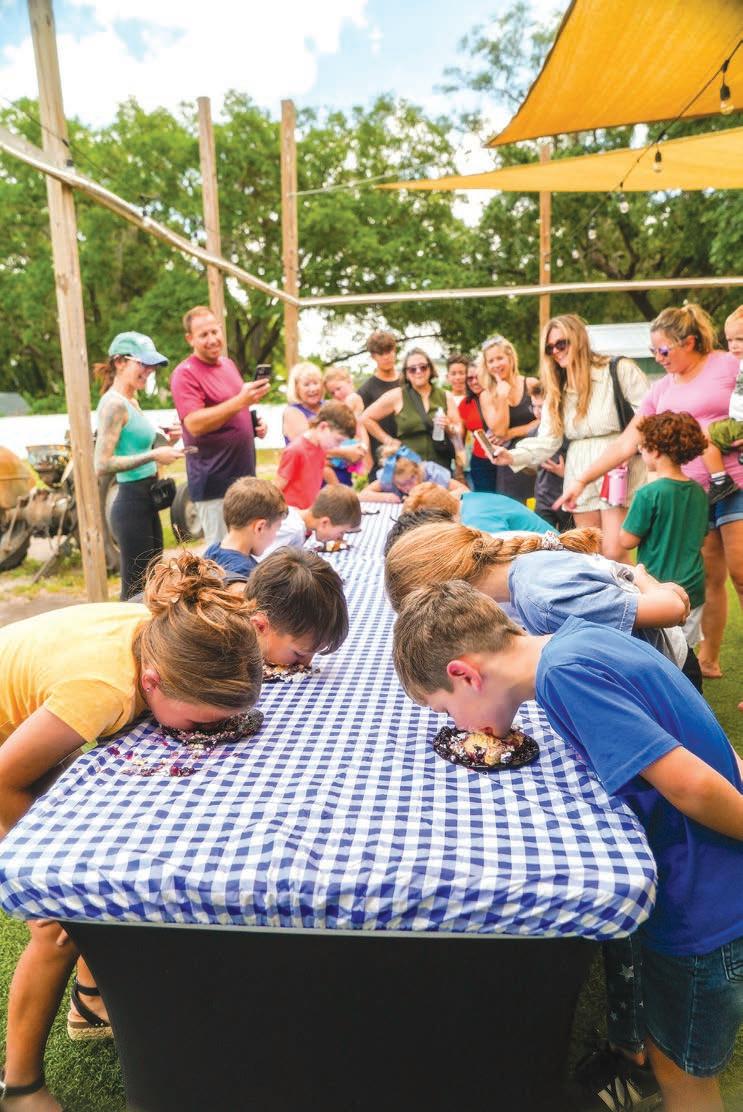




SATURDAY APRIL 26th • 11AM-3PM
Le Meridien HoteL • Downtown TampA
Get your tickets now - going fast! Check out our permanent jewelry artist, tarot reader, braid bar, complimentary chair massages, flower cart, mimosa shopping tent, and watercolor artist while listening to live music and enjoying the beautiful downtown historic courthouse.
Secure your VIP ticket for a beautiful gift from The Mimosa Club!
Supporting sponsors:




























Additional Experiences:






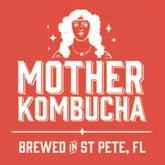









Be the first to sample Channelside Brewing’s Strawberry Tangerine Beer-mosa brew

“Our rivers and bays and creeks are open books, begging to be read.”
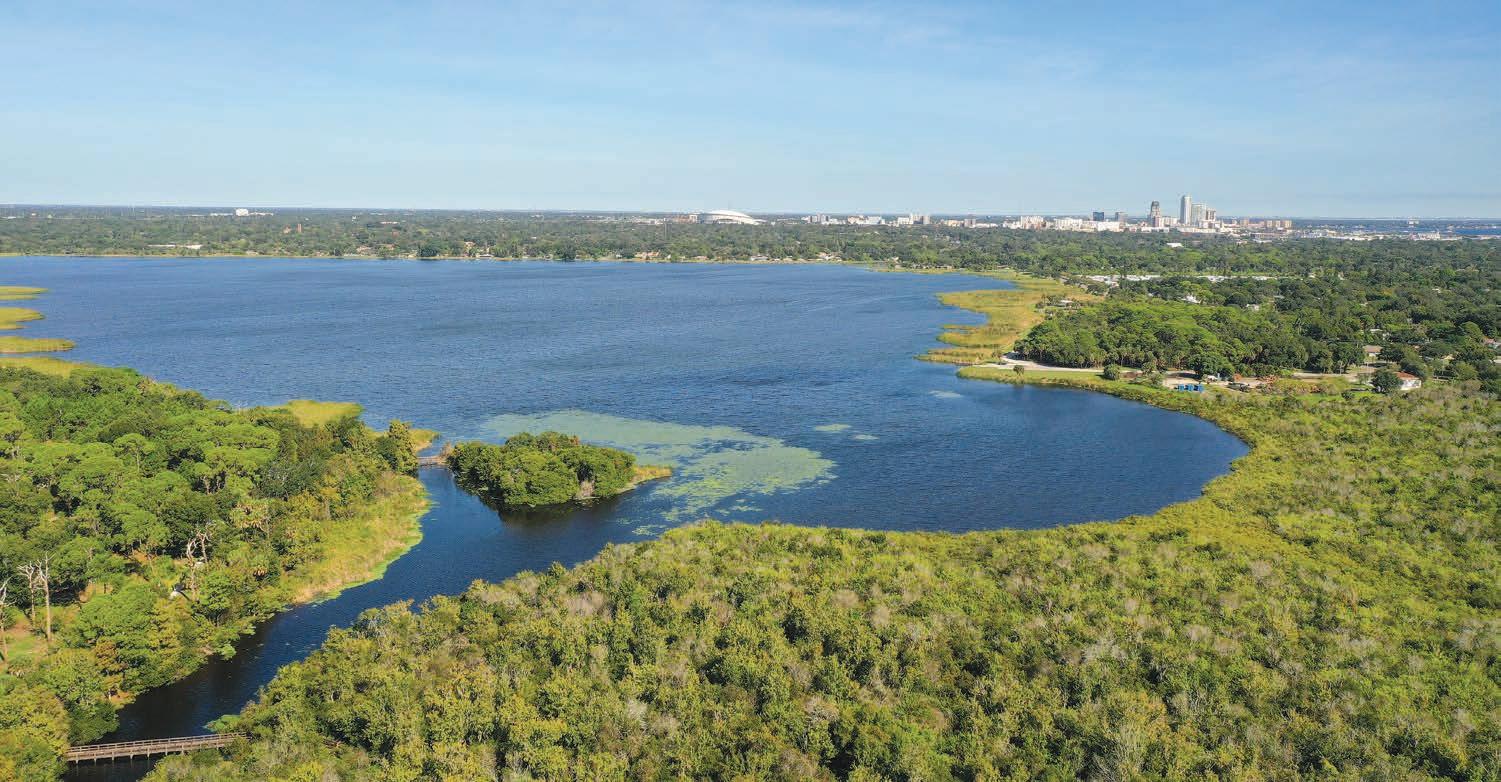
What are the human and natural stories that drain into the Gulf?
By Thomas Hallock
In between Hurricane Helene’s gusting rain bands, my wife Julie and I snuck outside to gawk. We met our alley-neighbor Rebecca, and watched bay waters crest the curb at Lassing Park, cross Beach Drive, and lap towards low-lying homes. We swapped tales with strangers near Salt Creek, which flooded (as it does with every big rain), transforming the city’s future Innovation District into a polluted marsh. We are drawn to storm damage like rubber-necking motorists. Only when the power transformers started to pop, sparking like roman candles on giant popsicle sticks, did Julie and head back inside—but not before reaching a major decision. Time to sell our home.
sits on the third floor of a condo overlooking Boca Ciega Bay. Most mornings, I get up to write and watch sunrise over finger islands and concrete seawalls, carved by developers in the mid-20th century from a mangrove-lined estuary. Most residents try to forget this ecological past, although Nature will not be ignored.
In our condo parking lot, storage pods mark the space of residents who still have not returned.
#Creekshed launch
Tuesday, April 22. 4 p.m.-5:30 p.m. No cover Nelson Poynter Memorial Library. 140 7th Ave. S, St. Petersburg. digitalcommons.usf.edu/creekshed
The decision to sell hit us hard. Still does. Julie and I lived in our 100-year old bungalow for 23 years. We bought when St. Pete real estate was still cheap and fixed the property up ourselves; we raised our son here; wrote books; and have built deep family, community, even religious ties.
Right now we are rootless, settled into a short-term AirBnB on St. Pete Beach. Our rental
The building’s first floor sits empty, gutted by flooding. Stacks of sheetrock await installation.
I am lucky. Julie and I suffered a tiny fraction of the $78 billion leveled by Helene. But I’m also haunted by the refusal to accept climate change. Erasures unsettle me. A gift shop down the street sells t-shirts, “Gulf of America—Founded 2025.” Our AirBnB, tastefully decorated beach in resort style, is designed to eliminate worry. On the bookcase in our living room, three decorative volumes declare the apartment’s message on the spine: “HAPPINESS / is not BY CHANCE / but by CHOICE.” But the pages are empty.
This special Earth Day issue of Creative Loafing Tampa Bay makes an attempt to fill the empty books. Along with Eckerd College Professor Amanda Hagood, our editor Ray Roa, and a team of USF librarians, we have asked 10 writers from around the Tampa Bay area and state to reflect on water and memory. We’re calling this project #Creekshed, asking “what are the human and natural stories that drain into the Gulf?”
Following that prompt, writers reflect upon any one item in the vast special collections at USF’s libraries. The responses are ekphrastic (an old poetic form in which the author speaks to a work of art) and located on a story map.
This coming Earth Day, Tuesday, April 22 at 4 p.m., we’ll launch the website with a celebratory reading at Nelson Poynter Memorial Library on USF’s St. Pete campus. The event is free and open to the public. Please come.
We hope this #Creekshed project will continue, using artifacts from the past to chart a more sensible present and future. The waters of Tampa Bay will find us; it behooves us to learn the story of our rivers, streams, paved-over estuaries and sea-walled shorelines.
Change is tough. Changes hurt. Changes challenge us, especially in perspective.
When Julie and I sold our home, we both felt tremendous loss. We were fortunate. I have friends who were forced to rebuild, colleagues who still do not have a home. A few years back, the academic geographer Yi-Fu Tuan coined a
term, “topophilia”—love of place. Topophilia does not mean blind patriotism, or simply enjoying a bay view (while sheetrock is stacked in the parking lot). The concept asks us to dig deeper. We must sift through the good alongside the bad of our history, the joy alongside grief.
In assembling our #Creekshed team, we sought writers who provide diverse perspectives. We have gathered together poets (Sheree L. Greer, Tyler Gillespie, Gloria Muñoz), historians (Jack E. Davis, Gary R. Mormino), literary critics (Julie Armstrong, Amanda Hagood, myself), songwriters (Rita Youngman, whose song appears online), and journalists (Diane Roberts).
Now is the time for conversation and reflection.
Like a molting crab, without shell or home, my base instinct is to find a rock and hide. The writers for this project instead encourage us to embrace topophilia, our love of place—what the Kiowa novelist N. Scott Momaday courageously called “the remembered earth.” In the lull before our fast-approaching hurricane season let’s look for the community alongside the isolation, the memory against loss—the wisdom and folly that comes with living where water meets land. Our rivers and bays and creeks are open books, begging to be read. We erase these stories from our pages at our peril.
As the prophet David writes, “turn and face the strange.”
Come. Let’s read—and change—together.






Maximo Beach

Julie Buckner Armstrong is Professor of English and Frank E. Duckwall Professor of Florida Studies at the St. Petersburg campus of the University of South Florida. Armstrong is the author of “Mary Turner and the Memory of Lynching,” among other works. Her most recent book is “Learning from Birmingham: A Journey into History and Home.”
Jack E. Davis is Distinguished Professor of History and the Rothman Family Chair in the Humanities at the University of Florida. He is the author or editor of 10 books, including the Pulitzer Prize-winning ”The Gulf: The Making of an American Sea,” and he is currently at work on a new book, tentatively titled, “The American Coast: History and Prophecy at Land’s End.”
Tyler Gillespie is the author of “The Thing about Florida: Exploring a Misunderstood State” and “Florida Man: Poems, Revisited,” among other works. Gillespie currently teaches at Ringling College of Art and Design, where he is the Writing Program Coordinator.
Sheree L. Greer is a writer, teacher, and arts administrator. She is the author of two novels, “Let the Lover Be and A Return to Arms.” In 2014, she founded Kitchen Table Literary Arts, and she is a founding member of the southern arts collective, The Rubber Bands.
Amanda Hagood teaches in the Animal Studies program at Eckerd College. Spanning academic and public-facing writing, Hagood has published in academic journals such as “Interdisciplinary Studies in Literature and the Environment and Environmental Humanities,” as well as in popular venues such as “The Marjorie.”
Thomas Hallock is a Professor of English at the University of South Florida, where he teaches primarily on the St. Petersburg campus. Hallock’s previous publications

include “A Road Course in Early American Literature: Teaching and Travel from Atzlán to Amherst,” and “Happy Neighborhood, poems and essays.”
Pedro el Poeta Jarquin is an award-winning hip-hop, spoken word, and freestyle artist, an activist, a proud father of two, a teacher, and an Eckerd College graduate with a B.A. in Creative writing. Born during the civil war in Nicaragua, Jarquin immigrated to the U.S., becoming a political refugee at the age of six, and grew up in the Washington D.C. area. Jarquin has been performing from an early age, and since moving to St. Petersburg, has been a vital figure on the Tampa Bay spoken word scene.
Gary R. Mormino, Frank E. Duckwall
Professor of Florida History, is the author of “Land of Sunshine, State of Dreams: A Social History of Modern Florida,” among many other works. In 2003 the Florida Humanities Council named Mormino its first Humanist of the Year.
Gloria Muñoz is the author of “This is the Year, Your Biome Has Found You,” and ”Danzirly,” which won the Ambroggio Prize and the Gold Medal Florida Book Award. She is St. Petersburg’s current poet laureate, and the first Latina to hold that honor.
Diane Roberts is Professor of English and University Alumni Distinguished Writer at Florida State University. She is the author of “Dream State: Eight Generations of Swamp Lawyers, Conquistadors, Confederate Daughters, Banana Republicans,” and her most recent book is “Tribal: College Football and the Secret Heart of America.” Since 1993, Roberts has been a commentator for National Public Radio.
Rita Youngman is the granddaughter of Toby and Rosa Johns of the Brighton Reservation. She is a member of the Seminole Tribe of Florida and the original Bird Clan. She is a singer-songwriter who focuses on Seminole history.



















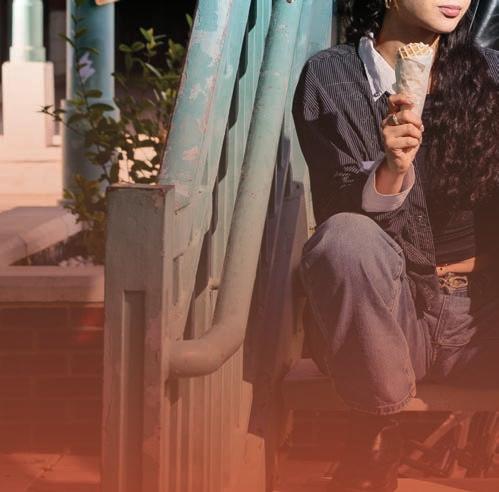
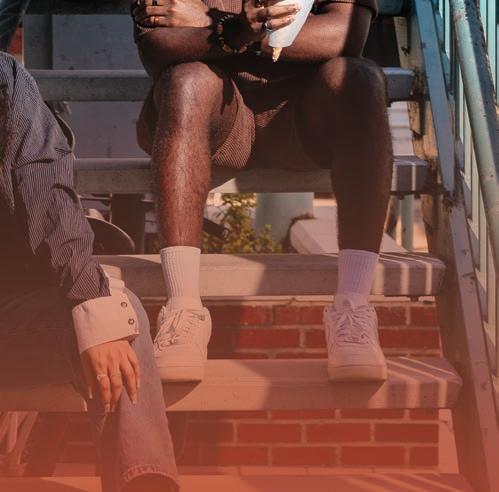






By Sheree L. Greer
At Lake Rogers Park, there is a blue trail, a red trail, and a green one, too. Whether the upper or the lower, you’ll fi nd yourself walking on the edge of water and memory, the ground uneven, roots like veins, where stories of bloodlines and buyouts, history and home, shapeshift beneath the sand.
What grows here:
Pentas–tiny, pink, and puckered closed for now–are hushed and holding secrets. Littoral zone lily pads float unbothered and unbloomed until spring comes. Cordgrass swaying in greens and golds, whispering the names of families come and gone. Fakahatchee, forceful and full, run up to the shoreline while bold, bright green Christmas ferns blanket the sandy loam beneath the hammocks. Palmettos wide and watchful, a rustling choir of narrators each with a different point of view. And of course, the water.
Lake Rogers invites you to hike, to listen, to learn, to glance quick and sure over your right shoulder, through the Wax Myrtle, Oak, and Muscadine, where more/different/other stories of water meeting land are longing to be revealed.
Neighboring lakes recorded and/or remembered—Raleigh, Walker, Pretty…
Named for/by Black families pioneering and formerly enslaved. Nearby histories that make headlines for mere moments before settling back into the sunken graves across Gunn Hwy, beneath farm and barn; voices calling from behind the motel, beside the schoolhouse, and beyond the steeple.
Blue signs denote private roads, red signs with white letters threaten, no matter how clear the call of the storied and beckoning bushes, grasses, and trees.
What begs to be known here:
The careful attention to truck and dredge sand to shore–a beach of our own against the constant “No” of segregated shorelines and parks, and an inclination to defi ne for ourselves what it means to belong, to be welcomed, to submerge into water that cools and comforts in a world that silences and shames. Over there, my cousin in a wide-brimmed hat, a sunflower-yellow ribbon wrapped ‘round, matching the stripe of big sister’s new bathing suit or swim trunk waist band, held bunched in little brother’s hand.
Squinting through the sunshine, trilling laughter and staticky radio Smoking grills and smoldering cigars, salty shoulders and sweet citrus Sight, sound, smell, and taste recall a place to rest, relax, a conversation between past and present, narratives from city to country and back again, an echoing history of beautiful sun-kissed Black bodies
swimming and playing in the gentle ripple, the lake’s gladness and gratitude splashing up and out, catching light like diamonds.



























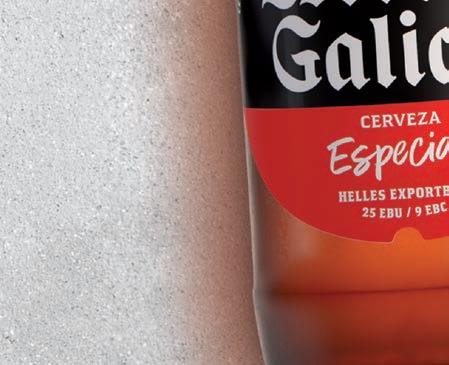
















I
On the Corner of 14th St. and 19th Ave., on a cool, late-February evening, she stands.
Tall. Majestic. Full of life.
The heart of a city that moves to her beat. She is the buzz in the streets. She is the buzz in the hundreds of homes that depend on her even to eat. Yes, she is the buzz in these streets. She is the pillar the whole town was built on. The Cuban, the Spanish, and Italian immigrants, all of them move to her beat.
Life blooms from the buzz that she stirs. Her and the two hundred others like her. They are the arteries maintaining harmony. If any one of them left, it would hurt. And it did…
No one could’ve imagined it. Nobody could’ve warned her, that this cool, February night would be her last night on this corner.
On the northeast corner of 15th St. and 9th Ave., he sits.
Proud. Humble. Tired from a long week’s work. The buzz from the other factory workers all around him as he orders another Florida Ale. It’s Saturday night, and payday is play-day.
All of this goes without fail.
A couple cervecitas, a game of Bolitas, in a place where no boredom prevails.
So he catches a buzz, not a care in the world, and prepares to go home to his girl. Not knowing the impending doom up ahead. Tomorrow, he’d wake in a whirl.
By Pedro el Poeta Jarquin
It was on the corner of 20th St. and 12th Ave. that the flames were fi rst spotted. Those ferocious flames that seemingly swooped in as if in a fit over the profit the town had been making, and all of the buzz it had gotten.
March 1st, 1908, a date that cannot be forgotten.
More than thirteen blocks scorched. Forty-two businesses lost.
Two thousand, plus, without homes. Just as many without jobs.
How would the city survive? How could it once again thrive?
Its people.
Its people knew that the phoenix’s story was not a story of demise. So they organized. Rebuilt. Fought fears.
A city baptized in their sweat.
A people strengthened by their tears. Ybor city…
Just one of the stories drained into our gulf throughout the years.








































































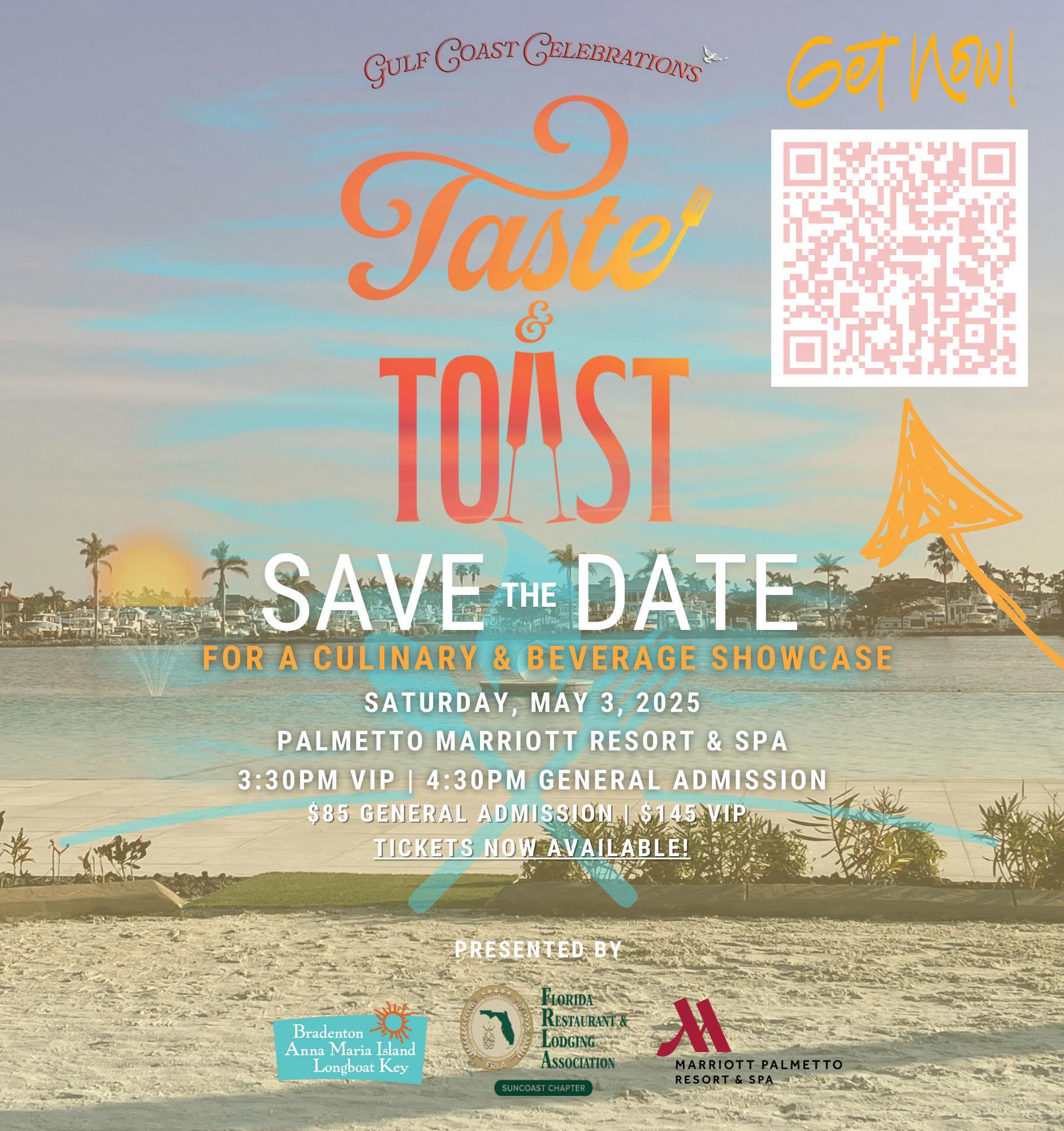
By Gary R. Mormino
Behold the Sunshine State’s cornucopia: Plant City strawberries, Ruskin tomatoes, Frostproof oranges, Dade City kumquats, Cedar Key clams, Chassahowitzka pompano, and John’s Pass mullet.
But no other local foodstuff has meant so much for so long to so many as Tampa Bay oysters. If, as Jonathan Swift insisted, “He was a bold man who first did eat an oyster,” so, too, is any reader who has sampled a local oyster recently.
Alas, the Tampa Bay oyster appears to have joined Zellwood sweet corn, the scrub jay, and Yellow-Dog Democrats as symbols of a vanishing Florida.
For thousands of years, Native Americans relied upon the oyster as an indispensable food source and building material. From Crystal River to Terra Ceia, from Spanish Point to Pine Island, hundreds of shell mounds and middens stand as testament and sentinel to the Indians’ religious and dietary customs.
Historian Ray Arsenault writes, “Prior to the founding of St. Petersburg, there were at least seven mounds in the Booker Creek-Big Bayou area of the peninsula. Shell Mound Park was built to preserve the area’s last surviving mound, but it later fell victim to hospital expansion.” Tampa also had an immense mount located at the water’s edge of today’s downtown.
It was a ceremonial mound that soldiers at Fort Brooke built a Japanese pagoda at the crest. That mound also fell victim to modernization, hauled away in carts to be used as street fill in 1876. When cartographers charted Florida’s waters, they named bodies of water and islands after the mundane mollusk: Oyster Key, Oyster River, and Oyster Bay.
on trees!” observed McCall in his diary. Lining the banks of bays and rivers were miles of mangroves and during low tide, bushels of bivalves—called “coon oysters”-- could be harvested simply by plucking the mollusk clinging to the exposed limbs.
“By and by,” exclaimed McCall in his diary in the Spring of 1824, “the lower [Tampa] Bay is the finest oyster-ground on the continent. . . .
I have not eaten such oysters anywhere. A boat’s crew is detailed from the command twice a week, and they never fail to procure enough for all.”
McCall survived the Second Seminole War and lived to fight in the Mexican War and Civil
In the late 19th century, Tampa Bay oysters acquired a status among epicures. Noted the Tampa Tribune, March 7, 1887: “Tampa Bay oysters are fine and sell for one dollar a barrel at the wharf.” Fishermen brought to market prodigious quantities of Weedon Island, Rocky Point, and Cockroach Bay oysters—in their day equivalent to those prized mollusks from Chesapeake Bay and Wellfleet. Rich and poor feasted upon oysters fried, roasted, baked, fricasseed, and stuffed, but mostly they were slurped raw with brine still dripping from their shells.
Oysters were so prolific and cheap that denizens of New York City feasted frequently upon the mollusk that Mark Kurlansky titled his 2007 book about the subject, The Big Oyster.
In 1907, the St. Petersburg Times noted that Captain F.W. Taliaferro and sons “are very
Health condemned the oysters harvested in 22 areas, including Tampa Bay.
As late as 1950, on a stretch of beach from Pass-a-Grille to Bellaire, only one Pinellas County municipality had invested in a modern sewage system. The septic tank might qualify as the Florida mascot.
Oysters are so extraordinarily resilient that they can filter 50 gallons of water a day. Progress bore a price. Decades of dredge and fill, countless septic tanks, and three cross-Tampa Bay bridges destroyed much of the once prolific oyster beds. In 1963, a headline in the St. Petersburg Times warned, “Typhoid on Half Shell Lurks on the Suncoast.”
The construction of Davis Islands, Snell Isle, and the Gandy and Howard Franklin bridges, made possible the good life for generations of Floridians, but such dredgeand-fill operations doomed the oyster reefs.

In 1824, Lt. George A. McCall sailed into Tampa Bay, part of a military vanguard that established Fort Brooke on the Hillsborough River. McCall was a remarkable soldier and observer. A graduate of the U.S. Military Academy, class of 1822, McCall kept a meticulous diary, later published as a book, Letters from the Frontiers. I found the handsome book decades ago at Special Collections, USF Tampa. A gourmand, McCall held the Tampa Bay oyster in special exaltation. “Oysters growing
War. A Pennsylvanian, he was captured by the Confederates and released in a prisoner exchange for the much- decorated Confederate with the colorful name, Simon Bolivar Buckner. His son, Simon Bolivar Buckner Jr. was killed by a Japanese sniper at the Battle of Okinawa in 1945. My father, who participated at the battle, talked frequently about that tragedy.
McCall was not alone in his praise for Tampa Bay. Clement Claiborne Clay spent the winter of 1851 in Tampa. An invalid, the future U.S. Senator had come to Florida for rejuvenation. Clay’s health improved dramatically, in part, because of his consumption of a local delicacy.
“He sighed, “The oysters caught in the bay are larger and finer than any I ever saw.”
busily engaged in the midst of harvest on their oyster farm at Big Bayou, which this year has a very large crop of the finest quality.”
Locally, the R.S. Warner & Co. employed seven boats to stock Rocky Point oysters at its Port Tampa location. With affection, Cortez fishermen referred to Palma Sola Bay as “the kitchen,” because of the rich yields of oysters and scallops harvested there.
Hell-bent for commercial supremacy, Tampa and other communities paid little attention to the health of the bay that made possible prodigious harvests of fish, scallops, conch and oysters.
Well into the 20th century, cities routinely dumped raw sewage into the bay. An early warning occurred in 1945 when the State Board of
Global warming—blamed for everything from recent hurricanes to the election of George W. Bush—also contributed to the demise of Tampa Bay oysters. Changes in the balance between salt and fresh waters also disrupted oyster beds.
It is unclear just when locally harvested oysters disappeared from menus, but in February 1981, Robert Boyle eulogized in the Sports Illustrated swimsuit issue, “Tampa Bay, once a glory of a state, is filth. It’s a mess. There will never be an oyster in Tampa Bay again.” Christie Brinkley appeared on the cover.
The eulogy was premature. Marine biologists and Sunday boaters confirm that oysters do grow in Tampa Bay, but most are the inferior “coon oysters,” not the more glamorous Raw Bar, Eastern delicacy, “Crassostrea virginica.” Today, only a small reef near the Sunshine Skyway Bridge is suitable for oyster harvesting. Perhaps one day, future generations will sit down to a plate of Tampa Bay oysters. If so, we should flock to a vintage theatre to enjoy the 1965 film “The Amorous Adventures of Moll Flanders,” with its memorable bivalve seduction scene—over a plate of oysters.
Considering the health warnings in recent years about raw oysters, keep in mind Roy Blount Jr.’s “Song to Oysters”:
“I like to eat an uncooked oyster
Nothing’s slicker, nothing’s moister. . . (but) I prefer my oyster fried.
Then I’m sure my oyster died.”

By Amanda Hagood
JUMP! Said the markered note scrawled into the timber Of the wooden tower overlooking the bay: As the mangroves clawed at the subsiding shoreline As the distant highway hissed at the horizon As an osprey rode on invisible currents. Another scribbled message cried out: PRAY, PRAY, PRAY.
A palm tree inclines its spiky crown, as if to pray In an old postcard, among jungled timbers: Beautiful Maximo, defi ned by the currents Of Frenchman’s Creek converging with the blind-mouthed bay. The happy snowbirds’ lens inscribes this horizon: A paradise of sunset, shell, and shoreline.
I walked beside my mother. She scanned the shoreline And leaned upon her cane, gazed down as if to pray. A distant storm front piled clouds on the horizon. Her eyes lit on a lightning whelk trapped in timber At the base of a palm tree, exposed by the bay. We traced its graceful curvature, felt time’s current Electric through its whorls. I expounded current Archaeological theories, noted the shoreline: Thousand year old middens eroded by the bay, Oyster domes assembled like penitents who pray Deliverance from the flood. Another timber Memo read: HONOR THE OCEAN. The horizon
Is dimmer these days; no more the bright horizon That drew folks toward their golden years, like a current. But something more fragile, wanting care. In timber’s Or water’s recordings, that’s clear. We sat, shoreline Before us, and maybe, not exactly, we prayed, Raised thanks for our Pub subs, for this beautiful bay,

For the privilege of feasting where remnants of bay Scallop and oyster stretched thick to the horizon. Like the faithful frolfers, so we, ploddingly, prayed For this muddy sponge of time, soaked by currents, And the rapt beachcombers of a future time’s shoreline. Proclaiming the wisdom in the tower’s timbers:
THIS SPOT RULES! we did pray. Let’s abide by this bay Seek truths in its timber; dream beneath its horizon: Ripples in time’s current, footprints on the shoreline.











At Mo tt, we understand that a breast cancer diagnosis can feel overwhelming, but you are not alone. Our world-renowned cancer experts o er comprehensive risk assessment, individualized treatment options, advanced surgical techniques, breast conservation procedures and early access to novel immunotherapy clinical trials - in a single location.
Choose Mo tt—the #1 Cancer Hospital in Florida and the Southeast. Schedule an appointment today at Mo tt.org/BreastCare or call 855-751-2115.








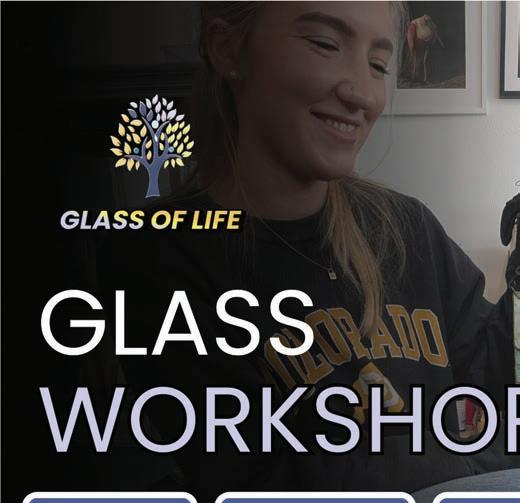






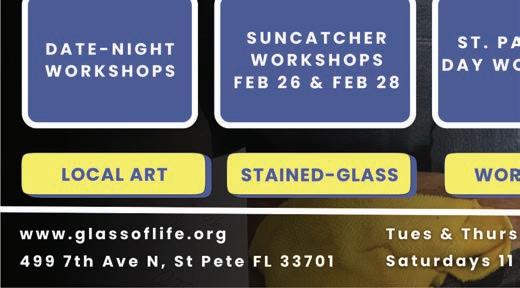

By Jack E. Davis
We probably should have stayed out of St. Petersburg’s Lake Maggiore 40 years ago.
But we wanted to water ski, JT, Rick, and I. We drove 45 minutes a few times a week from Largo towing my 15-foot sun-faded aquagreen ski boat, tangling with the rambunctious traffic on Ulmerton Road before entering the southbound onramp to the hurtling interstate, exiting at Martin Luther King Jr. St S for the last two miles to the wild and not-so-wild of Lake Maggiore.
The wild was the congregation of alligators that trolled the lake. The not-so-wild was the polluted water. It didn’t emanate a foul smell, but it didn’t offer that redolent aura of wholesome water either. If you dunked your hand in, it quickly disappeared in the eutrophic turbidity.
“Impaired” is the word scientists and bureaucrats deployed to describe polluted water bodies, which we use for drinking, recreation, and waste disposal, mindlessly flushing what we don’t want into a life necessity, mindlessly tolerating the absurdity of this eternally unbroken circle, mindlessly spoiling our homeland and that of every other species, carrying out these agendas with inviolable hubris. Maggiore had a full complement of impairments: nitrogen overload, mercury contamination, low dissolved oxygen, high dissolved solids.
reedy edge of Boyd Hill Park palisaded its southern rim, tidy houses huddled in sunburnt grass sodded the northern, and the park squatted disconsolately on the east. The attraction for us was what it lacked—the lashing, wake-making recreational boat traffic of every other lake— and what it offered—a slalom course set up with buoys anchored in the mucky bottom. After launching, we became the lake’s uncelebrated lashing energy, bane of the sodded neighborhood, revving up high decibels by racing the boat through the slalom course to chase away alligators before one of us dropped over the side with a ski.
We were young and reckless and, like Tom Cruise in “Top Gun,” feeling the need for speed. You ran the course as fast as possible, peeled out from the center toward the first buoy and, with one hand gripping the rope handle and arm outstretched, leaned low to the right, torso inches from the water, rounding the buoy, rooster tail flying, then pulled the handle with both hands vertically close to the chest, sweeping back toward the wake hard and fast, crossing it and shifting your weight to the other side, easing your speed and targeting the next buoy to mirror the previous motions.
Who knew? Not we, even though nearly every water in Florida was unsafe for swimming and fishing. The powers that be undermined Maggiore’s health when they decided to finesse the natural watershed of which the lake is a part, the Salt Creek system. That happened in 1941. Maggiore had been a brackish bayou, fed by freshwater springs and Tampa Bay, drinking in saltwater during high tide and expelling it during low, a natural cycle that rankled a throbbing growth industry preferring fresh over salt and human control over nature’s. The solution: enlist engineers to build a tidal gate—a “barrier against pollution,” said the local newspaper— to keep out the salt. The consequence: a robust bayou subverted by a stagnant lake unable to flush humanity’s hubris.
We might have taken a hint—if we were interested—from the sullen park where we launched the boat. Pinellas County had not yet passed a penny sales tax to, as the St. Petersburg Times put it, “provide plenty for parks.” Maggiore needed plenty. The grass was sparse, the picnic tables splintered, the pavilion spurned, the boat ramp spare.
The lake itself, 363-acres and triangular, was undramatic in size and appearance. The
Back in the boat—shoulder, forearms, and thighs aching—the sun warm on your back, you’re in the thrall of a runner’s high. You go again and again, until the gas or sunlight gives out. Would I 40 years later? Surfers say members of their breed never retire. I understand. I need to find a boat, a ski, a course, and clean water.
Maggiore is still impaired.














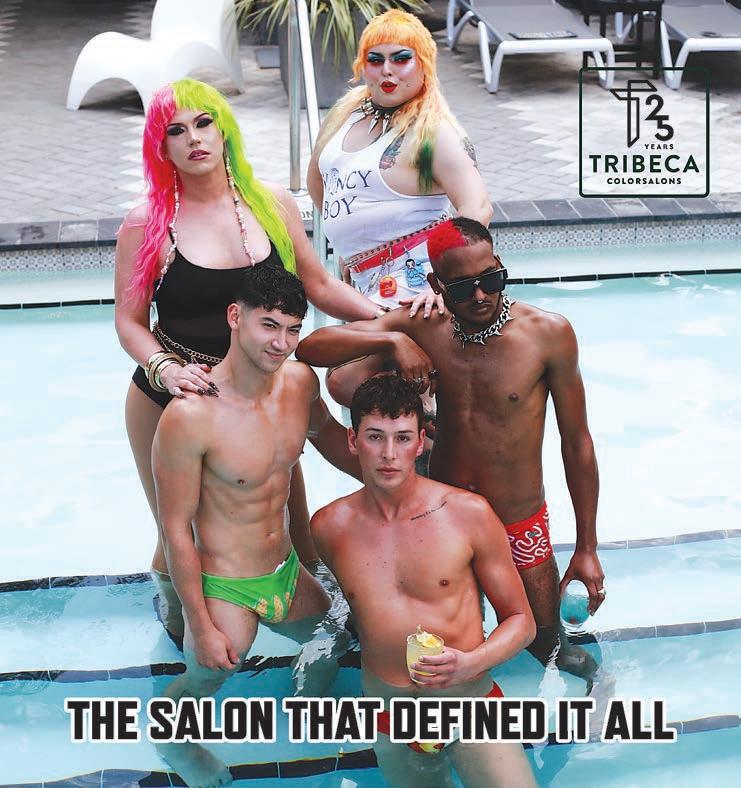
1 Lake Rogers
Sheree L. Greer seeks out beautiful Black nature and the legacies of segregation.
Pedro el Poeta recovers Tampa’s Latino foundations.
Julie Buckner Armstrong crosses the bay with a civil rights legend.
Gary Mormino reflects upon shell middens and Florida foodways.
Thomas Hallock mourns an untimely death on Treasure Island.
Historian Jack E. Davis water skis a polluted lake.
Amanda Hagood reflects on hidden landscapes and aging.
Singer-songwriter Rita Youngman chronicles Tampa Bay’s overlooked Seminole past.
Diane Roberts mourns the destruction of Native architecture.
Poet Tyler Gillespie road trips with a Swamp Monster.








By Julie Buckner Armstrong
In August 1927, Father John Culmer, Vicar of St. James, drove across the newly built Gandy Bridge from Tampa to St. Petersburg. His mission: bring the Eucharist to Black Episcopalians denied a place at God’s whites-only table. What did he think about as he headed west?
Lift every voice and sing
Till earth and heaven ring
Ring with the harmonies of Liberty
Perhaps he considered the ancestors whose paths he followed: St. Augustine of Hippo, a north African bishop and, later, namesake of the St. Petersburg church that Father John helped to found; Absalom Jones of Philadelphia, who led the United States’ fi rst Black Episcopal congregation; James Theodore Holley of Haiti, the world’s fi rst Black bishop.
Stony the road we trod
Perhaps he envisioned, in the hot light of sunrise behind him, the cold realities that a Black church in a segregated city might one day face: that a young couple wishing to marry in the cathedral would be told to use the back door; that sister Episcopalians, as the neighborhood integrated, would load their whole building onto a flatbed truck for a two-mile move to the white side of town; that the church he founded would one day make its own move, as the city declared the neighborhood “blighted,” and took over by eminent domain the space it wanted for an interstate and a baseball field.
God of our weary years
God of our silent tears
Perhaps he dreamed of a future he could not yet know: his success as Archdeacon of Southwest Florida and Rector of Miami’s St. Agnes, the largest Black Episcopal church in the South; Pauli Murray (Jane Crow hero in a collar not a cape), the Episcopal Church’s fi rst Black female priest; Presiding Bishop Michael Bruce Curry, preaching at a royal wedding and reminding the world that Beloved Community takes continual work.
Yet with a steady beat,
Have not our weary feet
Come to the place for which our fathers sighed?
Perhaps what he really wanted was breakfast: after the wine and wafer, a communion of catfish, grits, mango, and papaya—a tradition that St. Augustine’s would keep for a century.
Facing the rising sun of our new day begun,
Let us march on till victory is won
Perhaps, instead, Father John, driving over Tampa Bay, mused: water gives life, water destroys, water washes clean.
Let our rejoicing rise
High as the listening skies,
Let it resound loud as the rolling sea
Perhaps Father John, crossing the Gandy, thought none of these things. Perhaps he merely opened his mouth wide and
Sing a song full of the faith that the dark past has taught us,
Sing a song full of the hope that the present has brought us.












By Diane Roberts
The Madira Bickel mound sits in tree-laced splendor on Terra Ceia Island, ringed around with slim silver palms. It’s at once lush and eerie, a secret place, dim under mosslooped oaks, a green chapel. It’s an easy walk to the summit: the mound is only 20 feet high now, though it was once much commanding. Up there, car noise from Highway 19 is muffled to near nothing; the everyday sounds from nearby houses with their pastel paint jobs and well-pruned bamboos stops like somebody flipped a switch. You hear mosquitoes whine, punctuated by the raspy call of a bird—maybe a skimmer? An egret? Look toward the bay and you’ll likely see a blue heron, rising up like a spirit. The present dissipates like smoke: it could be 1,000 years ago.
Key to Hillsborough Bay to the Alafia River to Bullfrog Creek to Maximo Park to Philippe Park. Some were middens, some topped by the chief’s house, some crowned by the house of the dead. Others were temples, places where the human and the sacred meet. The society which made the mounds is gone, wiped out by European diseases or European swords.
Florida’s Safety Harbor mounds were built between 800-1450 A.D., often on top of Weeden Island mounds raised three or four centuries earlier. By 1100, a chain of grasscovered mounds, made of earth and oyster shells, watched over the waters from Crystal River to Weeki Wachee Springs to Anclote
In Florida, the past makes us uncomfortable. The past is inconvenient. We build hotels and strip malls and retirement villages on what we choose to see as empty land; we impose on the marshes and beaches and mangrove swamps cities fancifully called “Treasure Island,” “Bayshore Beautiful,” or “Holiday,” congratulating ourselves on our optimism, our modernity, our impermanence. We assume pre-Ponce de Leon Florida was mere wilderness, outside of history, until European eyes feasted upon it. But that’s our ignorance. The peninsula has been inhabited for 14,000 years. At the turn of the first millennium A.D., over 100,000 people lived here, speaking a variety of languages, organized in various social structures with sophisticated art forms and
complex religious systems. Florida is old—as old as Lascaux, as old as the Pyramid of Djoser, as old as Stonehenge.
By 1163, when French master masons began laying stone for the cathedral of Notre Dame de Paris, the Tocobaga temple mound on the west shore of Old Tampa Bay had been standing for a century. Three hundred miles to the north, the Apalachee were raising six great mounds on the shore of what we now call Lake Jackson. The Apalachee technically belong to Mississippian Culture, but their mounds were built around the same time as the Safety Harbor ones and look pretty similar. The house I grew up in sits about a mile as the crow flies from these mounds. My brother and I—amateur archeologists of the worst kind—would dig in our back yard and find arrow heads, spear points, and pottery shards in the red clay. We felt connected to the mounds, though our ancestors came down to Florida in Andrew Jackson’s bloody wake, killing or running off the last of the people who made them. We’d sit atop the tallest mound listening to spring peepers croaking and the wind on the lake. When this land was part of a cotton plantation in the 1850s, the owner called it “the Mound of Dreams.”
with our zeal for destruction, then (belatedly) declaring them precious, we somehow need to see ancient people and ancient places as possessed of lost wisdom. There are those who believe the Tocobaga mounds protect Tampa Bay from hurricanes, a legend proved untrue by Helene and other storms. We forget the mounds were once the center of a vibrant society. When the Apalachee lived in North Florida and the Tocobaga on Tampa Bay, the mounds would not have been so reverentially quiet. These were towns, humming with commerce, craft, cooking, sport and ritual.
“We forget the mounds were once the center of a vibrant society.”
It’s almost impossible to avoid romanticizing the mounds. Having made them rare
Most of the mounds are now confined in parks with some anodyne historic marker off to the side. It’s as if a cathedral had been stripped of its statues and stained glass windows and fenced off: an impressive monument but devoid of meaning. Still, the beauty and mystery of the mounds draws me. Any place where people have planted their crops and birthed their babies and buried their dead for hundreds and hundreds of years, resonates with the deep past. Most days our modern senses can’t detect them, but if we take care to look around, we can see the old behind the new, and hear the ghosts speaking to us from 10 centuries ago.




By Thomas Hallock
In January 2023, I lost a family member on the beach at Treasure Island. He was young, too young, dying while doing the kind of thing we do when we are of a certain age. I’ve struggled with writing about him—his story is not mine to tell. While I was pondering and going nowhere, mulling over archived images of Treasure Island, my wife Julie reminded me how people make poor decisions at the beach all the time. (There’s a second story in here, the grief carried by a friend’s mother, whose fi rst-born was buried
alive while playing in the sand.) This poem is a modified pantoum, a poetic form in which the second and fourth lines of four-line stanzas go into the fi rst and third of the following. I’m grateful to my writer-friends for help with this piece, especially Heather Jones, who reminded me how the form leans into unreconciled loss and echoing time. Lastly, an English teacher who is into poetry cannot think about things like mortality and time without thinking about the original master of ekphrasis, John Keats.
Treasure Island. Nineteen Twenty-Three. Fourth of July. A wafer half-disc of sun, slotted on the horizon like an unspent silver gelatin coin, poised as if time itself could stop—which it does when you are on the beach.
An ungrounded power line runs out towards the horizon, feeding a streetlight on the dock—what could go wrong? After all, the rules are different on the beach. No one in their suspendered swimsuit thinks, I came here to die.
At a place called Sunset Beach, what could go wrong? In modern Florida, electric lights replace a dying sun. Teenage girls will starve themselves for a bikini. Boys dive into the pool from their hotel balcony.
My childhood friend’s mother lost her fi rst born son while he was playing in the sand—buried alive. You will learn to live with the loss, she said, you move on, though a parent never recovers from the loss of a child.
It’s a trick, how twilights linger on the Fourth of July. In gaudy, colorized postcards of this now pastel horizon, the power lines are gone, scrubbed out—maybe forgiving mistakes? Forgive. It’s what we do when we are on the beach.



by Gloria Muñoz
Everything in this state has an underbelly more putrid or more beautiful than what is on the surface. These petals the color of fairies’ lips can make anyone believe in magick. Nature is always in drag. An editor told me to stop using absolutes, but I can only write a poem how I scream, laugh, or sing—with my full throat— like these open-mouthed periwinkle heads cackling at the sky. Everything always is not as it appears. Beneath the green water, there are roots and bones and livings things that have learned to live among their dead. But what we see is the most fantastic version of fantastic in a state where songs are made of pythons’ hiss, where ghosts dance with Spanish moss, where everything is invasive, even the amoebas floating through our brackish veins.
Water—always plural—like flowers, reminds us of everything we want to hold onto.








by Tyler Gillespie
A mass of crayfi sh & snake bones crawled from the creek with an algal-bloom smile. It opened a mouth-pit full of alligator teeth that fell out like an anxiety dream.
I didn’t scream.
I was too drunk on optimism & in no hurry to leave the streambed. The ugly thing smelled like low tide microwaved to a million degrees. A gar spit from its midsection – as did an eel & bull shark. It had a friendly enough disposition, though.
Still, I got bored waiting for it to say something.
Then, the hideous creature asked for clean water. The monster didn’t speak English, but somehow, I understood its ancient language: a dial-up modem mixed with crashing waves. His voice – because this anthropomorphic version of climate used he/him pronouns – soothed me. I took his hand.
Which wasn’t an actual hand. Was a rotting manatee fi ngernail.
I led him to a restaurant to get a cool drink. You stink, said the hostess. She checked her list. Replied: Can’t seat you till 6.
I saw open tables. Was indignant. Took his gross fi ngernail hand & hit the asphalt in my electric car. Which actually runs on gas. I just pretended it was electric so my new boy friend wouldn’t think I was part of the problem, too.
Because this horror movie turned into a romance when I looked at the decomposed catfi shleech-creek-freak next to me & felt a deep, earth inclination.
What can I say?
I’ve always liked bad boys with a unique sense of smell/style. We drove for miles. Got stuck in stop-&-go. Because that’s how it is in Florida now, no matter the time of day. It’s 1:45 on a Tuesday afternoon, like, where are all these people going?
The cars reminded me that some scientists believe we will never run out of water in Florida, but we may run out of time.
But that’s not something I can say.
To someone I’m newly dating, it would be too bleak. Too weird. So, I kept quiet & rolled down the window. Apparently, I wasn’t the only one attracted to this climate metaphor. Soon, a flock of seagulls flew into my car & nibbled on my man.
He asked me to pull over. & I did. He looked at me with swamp darter eyes. In his primor dial language, he said, We need to break up. It’s not you. It’s me.
I cried big, wet, brackish tears because I, too, am toxic.
Finally, composed, I replied I get it. I come from the city, you from the creek.
& he was like, Wait. Actually. No. It is you. It isn’t me. People did this.
A seagull picked a salamander from his flaky lips.
& I was like, damn, so you’re blaming me for the choices of an entire species.
& he was like, That’s exactly what I’m doing. Because you haven’t learned from the past & I was like, I’m trying to. I’m doing my best here. Sorry.
& he was like, No, you’re not. You’re just writing a story.
by Tyler Gillespie
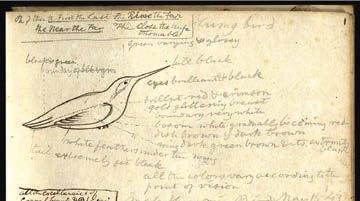


In the pages of his diary, Ellis Hughes sketched a bird next to some notes when he wrote about his tour as an Assistant Surgeon in FL during the Seminole War. Hughes documented people & places, mostly.
Creeks traversed. The rain. Soldiers, digging. So, this delicate bird caught my attention.
He described its eyes as “brilliant black” with crimson throat & “breast glittering gold.”
The pages are, like, two centuries old. A faint trace of his cursive memory. I put the digital diary in Photoshop.
The technology barely helped me better read thew past.
But this poem isn’t about what’s lost, details misheard or that ghostly bird sketch. There’s a different image below it. Hughes painted two glittering birds
with their long beaks crossed like swords or fi ngers or another appendage, extended like a line of thought. & maybe I’m just seeing what I want. His notes are all in pencil or pen.
These birds – maybe a type of wren – watercolor across its page. Soak his diary in orange, green.
A sunset red. & I won’t speculate on a man who’s dead.
Because there’s an ethic to the archive. Of handling people’s stories. But I will say that the birds look pretty gay. As in two dudes kissing. As in under a Florida moon, I met a man who I later called home. & the two of us made our nest from leaves & twigs & other scraps we found.
















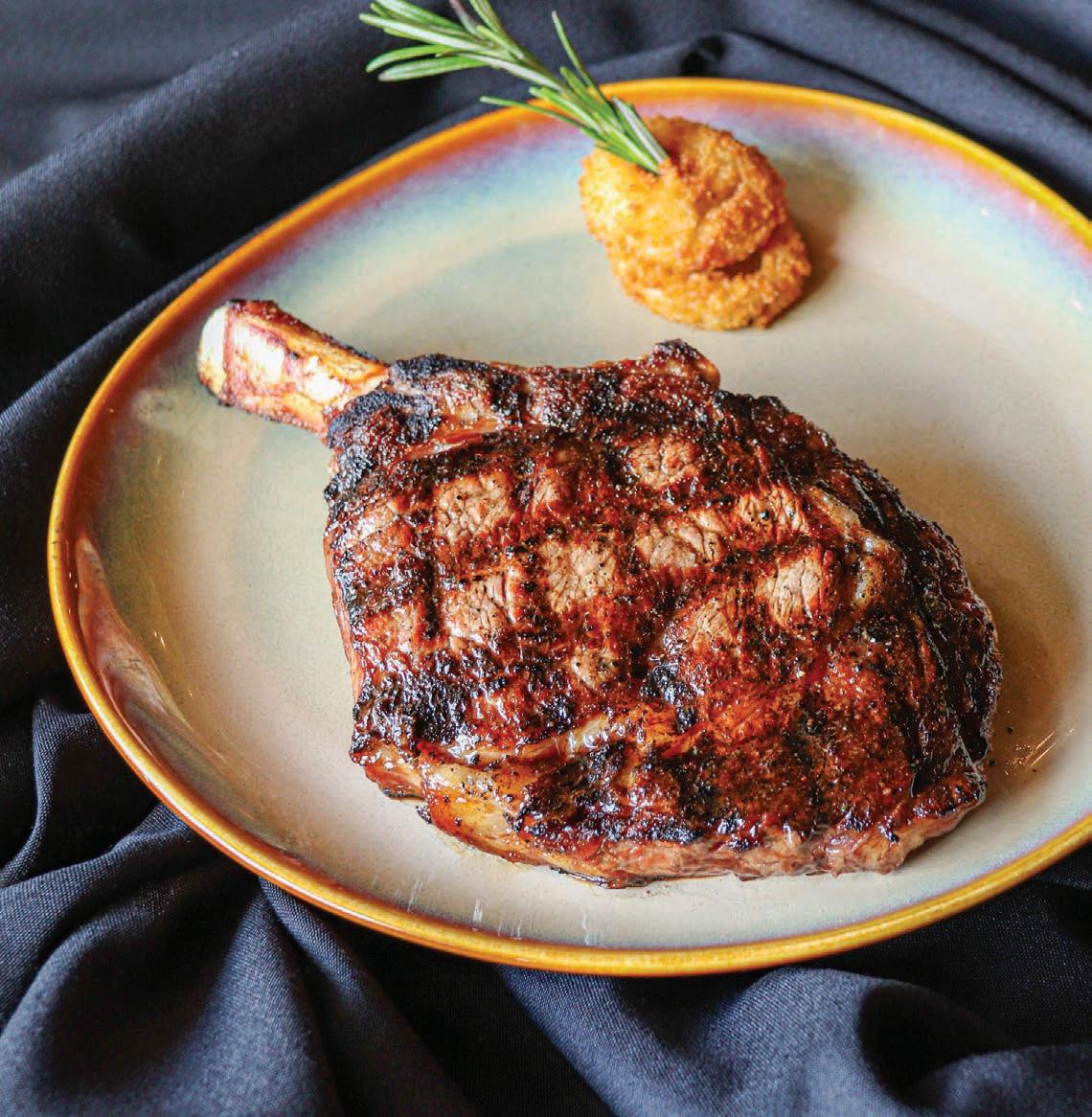










“ …the best time to plant it was 20 years ago. The next best time to plant it is today.”
By Linda Saul-Sena
Harold Walker was a dynamic leader. In 2013, he saw a man walking down the street with a clipboard and a city nametag. When Harold asked the man about his mission, he discovered that the laurel oaks lining the streets of his Hyde Park neighborhood were coming to the end of their lives.
The man said that the city was planning to remove all the laurels in this neighborhood. When Walker asked if there was a replacement plan, the man shrugged. He asked the City of Tampa staffer to hold off on the removals for a few months while he created a plan to replace them with live oaks.
For the next 10 years, Walker successfully led his neighborhood organization’s effort to reforest the streets with specimen live oaks, thus improving the environmental quality of the area. He worked with neighbors to get them to pay $1,000 each for particularly robust oak trees; the trees’ circumference was 10-12 inches—or as tree people say, four-to-five inches measured by calipers. Walker elicited his neighbors’ cooperation, having them sign a contract in which they promised to water these newly planted trees daily for four months at five gallons per caliper of trunk size. Daily. The result of his exacting program is the thriving ecosystem of trees on a dozen Hyde Park streets with names like Delaware, Morrison, S Boulevard and Newport. These trees will provide shade, clean air, and beautify the neighborhood for hopefully the next 150 years.
Walker explained his strategy of tree planting to an interested group of neighborhood leaders in February of 2025 for an event organized by the Tampa Bay Community Design Center (which in full disclosure is a group this writer participates in). Bill Carlson and Lynn Hurtak, two Tampa City Council members, joined the lively presentation by Walker and his son Taylor, who is the chief horticulturist for Bok Tower Gardens in Lake Wales. The presentation was inspiring, and Harold created a handout for each participant with information on how to successfully replicate this program in other neighborhoods. Dad spoke for 30 minutes, with Taylor expanding on the extraordinary contributions of live oaks to the local ecosystem.
“In addition to the oak’s beauty and shade,” Taylor explained “each tree creates its own microenvironment for insects and animals. When a row of oaks is planted, they literally support each other, sharing nutrients and growing roots which reach out to the fellow trees.”
Harold researched a commercial grower in central Florida whose trees were field-grown and placed into heavy gauge wire baskets lined with burlap. He personally hand-tagged the healthiest trees and supervised their delivery and installation. Harold—who was also the voice of Plant High School football for 15 years— worked with the Hyde Park Preservation Inc. to contribute funds toward the transport and
legacy. The tree canopy in neighborhoods beyond Hyde Park could use a leader like Harold Walker.”
Just a mile away on Davis Islands, one of Tampa’s storied neighborhoods is rapidly losing shade trees. True, the Islands suffered massive losses with the hurricanes last fall. However, the denuding of trees is due to more than the flooding. When Davis Islands was pumped out of the Hillsborough Bay 100 years ago, it had virtually no native vegetation because it had been a mud flat.
All of the landscaping has been created by homeowners who wanted a shady neighborhood. The iconic trees on Davis Islands were the Washingtonian Palms, which grew and grew and grew until they resembled something created by Dr. Seuss with a few palm fronds on top of a tremendously tall trunk. Things started to change for Davis Islands 35 years ago when the City of Tampa began offering free street trees in an effort to beautify the
the City of Tampa’s free tree program allows residents to select from a list of five potential trees, four of the five species offered are puny and provide little shade.
As climate change increasingly destabilizes our expectations for weather events, the roots of our trees are literally also destabilized. The result of shifting temperatures and flooding has resulted in a dramatic and painful loss of tree canopy on Davis Islands. Despite the efforts of the Tree Committee for the Davis Islands Civic Association, there has been a wretched net loss of shade and tree canopy.

installation of the trees and to help publicize the program which started in 2013.
For the talk, Walker and his son had planned a route along Hyde Park’s oak-lined streets to show the results of his tree planting campaign. They led the way down the block, explaining other trees in the area and how they interacted with the new oaks. But Harold sadly suffered a heart attack on the same day and did not survive. His legacy, those 201 glorious live oaks, will serve our community forever as a tribute to his vision and work.
Councilman Carlson told Creative Loafi ng Tampa Bay, “He showed that neighborhoods can work closely with the City to plant more trees and enhance our parks. We need to build on his
city. Residents took advantage of these programs and the neighborhood’s canopy began to grow. Most anyone might recognize one of these trees by their height today, from 20-30 feet.
Unfortunately, as real estate values have climbed, the size of the homes on Davis Islands has also grown disproportionately, fi lling the average lot from stem to stern. Current laws allow neighbors to be seven feet apart, but air conditioners, often massive and raised in the air to avoid flooding, can be three feet from the property line. Front setbacks are 20 feet and rear setbacks are often less, crowding every possible buildable inch of the lots.
Tampa Electric Company forbids oak trees to be planted under their wires, so even though
Harold Walker proved that a focused, organized approach to installing specimen oak trees can be successful. It takes leadership, organization and neighbors willing to invest in the planting of the trees and their willingness to keep the trees watered. The City of Tampa has proven to be a solid partner with Hyde Park, and has indicated that it would extend the same level of cooperation to any neighborhood.
As a result of Trump’s budget cuts, the City of Tampa lost $1.6 million which had been awarded for tree-planting under the federal program for environmental justice. The loss could be made up in local funds and would be a strong investment in a sustainable future.
In June 2024, the Tampa Heat Resilience Playbook was published online by the City of Tampa. It explains the dangers of extreme heat which is measured as over 90 degrees with high humidity. The numbers are mounting rapidly with 89 dangerous days with the heat index exceeding 100 degrees in 2022 and 100 dangerous days in 2024. Ugh!
This thoughtful analysis recommends planting shade trees throughout our neighborhoods because they create cooling corridors, lowering the air temperature up to 25%. Live oak trees are a “Keystone species” supporting more life forms than any other tree genus including fungi, insects, birds and mammals. These oaks stabilize soil, purify air and fi lter water. Live oaks rock!
Taryn Sabia, the Assistant Dean for Research at University of South Florida’s College of Design, Art and Performance, who led the Heat Resilience Playbook initiative observed,”we know the course of action we need but it takes leadership to get the trees planted.”
As everyone knows, a decent tree takes a long time to grow and the best time to plant it was 20 years ago. The next best time to plant it is today.




















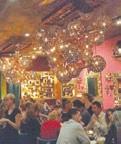










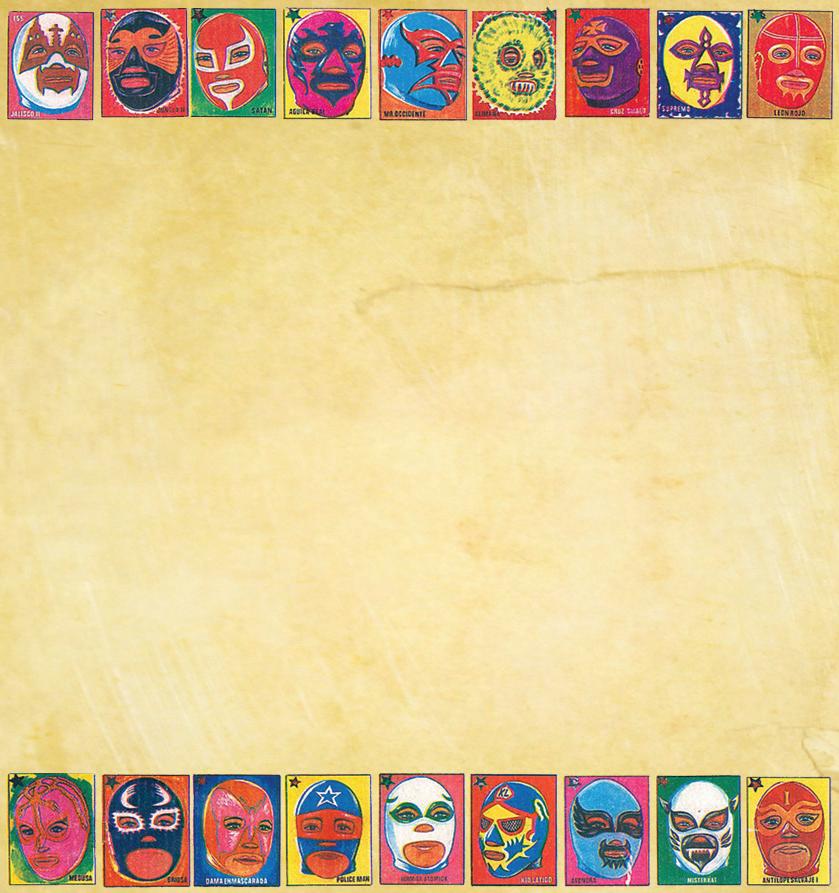




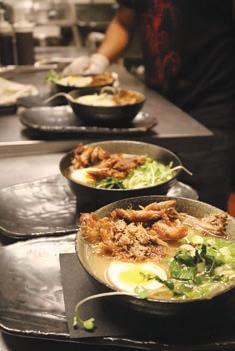
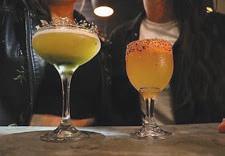












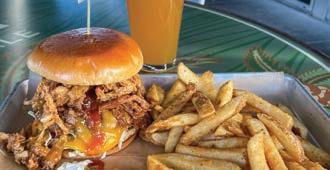














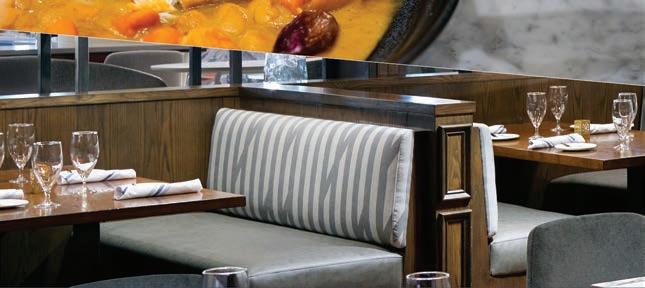




Treasure Island’s Thunderbird resort to be demolished—and rebuilt, plus more local news.
By Ray Roa and Selene San Felice
The Ikki Woo-Woo is about to be the Ikki Wah-wah. Last week, ownership at the Thunderbird Beach Resort said it’s demolishing—then rebuilding—the iconic, 68-year-old Treasure Island hotel.
In a social media post, ownership pegged the difficult decision on damage from last year’s back-to-back hurricanes. “After extensive evaluations and much deliberation, we were left with no choice but to move forward with a full redevelopment of the hotel,” they wrote.
The silver lining is that ownership, which said 80% of the resort has substantial damage, plans a complete rebuild that preserves the “...heart, soul, and charm that guests have come to love.”
The hotel really is a relic from the past, part of a St. Pete and Pinellas that sometimes feels like it’s slipping away.
“While the structure and layout will evolve, the spirit of the Thunderbird will live on,” Avi & Gilad Ovaknin, Owners, Thunderbird TI Holdings, LLC, added. “We look forward to sharing updates throughout this journey and can’t wait to welcome you back once the new Thunderbird Beach Resort is ready.”
The Goose was one of St. Pete’s last pool halls, and just christened new tables last month.
Known for hosting the work of local artists on its brick walls, the fi nal show will feature work from Regan McCreight and Dana Donkle through its last day on Sunday, April 20.
Co-owner Alex Gahhos wrote on the bar’s Facebook page that its lease wasn’t being renewed.
“This city was a different place when we began,” Gahhos wrote. “It’s lost a bit of its soul with all the out of state developers putting up condos, but, that’s progress.”
Engine No. 9, another local favorite in the same building, will remain open. Its owner told St. Pete Rising that he signed a 10-year lease last year.
Creative Loafing’s all-you-can eat Brunched event comes to downtown Tampa this month
And yes, the iconic neon—which serves as the unofficial welcome sign to folks coming to Treasure Island via the causeway—will remain.
The resort has not been in operation since last fall when Hurricanes Helene and Milton devastated the Bay area. Government officials would still have to approve the proposed rebuilding plans, according to WFTS, and there is no date set for demolition.
‘F*ck we’re cooked:’ St. Pete’s Wayward Goose bar and pool hall closes this weekend
After a decade serving drinks and hosting art shows, the Wayward Goose has been cut loose from its downtown St. Pete building.
Owners of the bar at 48 Dr. M.L.K. Jr. St. N announced its closure on Instagram this month with a chalkboard drawing of its blue-beaked mascot roasted like a Thanksgiving turkey and the words, “F*ck we’re cooked.”
Fuck that oatmeal you’ve been eating every morning. It’s time to get Brunched. Creative Loafi ng Tampa Bay’s annual celebration of Tampa Bay’s best indulgent breakfast-lunch combo offerings is back, now at a new location, downtown Tampa’s Le Meridien Hotel featuring Sal Rosa.
Everglazed Chicken & Donuts, Oystercatchers, and Latitude 28 are just a few of the restaurants sampling bites, with more restaurants being added to the lineup.
Of course, it wouldn’t be brunch without booze. Some of Tampa Bay’s best bartenders will compete for the coveted title of Best Bloody Mary. The winner, voted on by guests, will earn bragging rights and a feature at this year’s Best of the Bay event in September.
A portion of the event’s proceeds will benefit Current Initiatives of Tampa Bay, a nonprofit dedicated to community empowerment through programs like the Laundry Project, Hope for Homes Project, and Affordable Christmas initiatives.
Tickets to Brunched happening Saturday, April 26 are still available starting at $45— practically less than a dozen eggs.


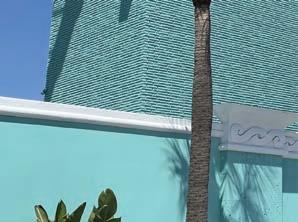


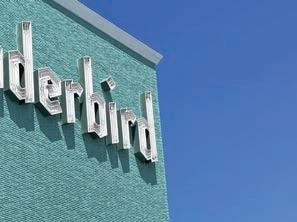


The VIP option includes entry at 11 a.m. (one hour before general admission), plus passed appetizers and fi rst go at the photo opportunities.
Tampa Bay Taco Week 2025 wraps this weekend, with specials on both sides of the bridge
Here’s something taco-bout this weekend. Tampa Bay Taco Week wraps this weekend on Sunday, April 20, after 10 days and nights of special deals on tacos and drinks at 18 different Bay area restaurants, taquerias and cantinas.
The $5 taco specials include: buttermilk fried mahi taco at Trophy Fish on both sides of the Bay, tres tacos and margaritas at South Tampa’s Taco Dirty.
Two-fer deals include a mix-and-match at The Brinehouse in Safety Harbor ($16), beer-marinated steak tacos at TBBC (aka Tampa Bay Brewing Co.), steak street tacos at all Taco Bus locations ($8.99), surf and turf at Marina Cantina ($15), and el jefe tacos at Ybor City’s Barrio Tacos ($15).
Other specials include the tacos gobernador at St. Pete’s Red Mesa Cantina ($11), plus fi let mignon tacos at the concept’s Cantina location ($16), and three-for-$15 birria tacos at Los Chapos Tacos in Ybor City (pictured).
Rene’s Mexican Kitchen in V.M. Ybor is even offering a three steak house taco platter while Pinellas gets an infamous Mexican pizza care of the mad scientists at Dunedin’s Madison Avenue Pizza (RIYL: throwback Taco Bell).
Freebie specials include chips with pico or queso at Jimmy’s Tacos (with the purchase of two entrees).
A portion of the proceeds from Tampa Bay Taco Week, brought to you by CL, go to the nonprofit Humane Society of Tampa Bay.
More information about Tampa Bay Taco Week—including rules for the Instagram giveaway featuring nearly $700 in winnings—is available via tampabaytacoweek.com.



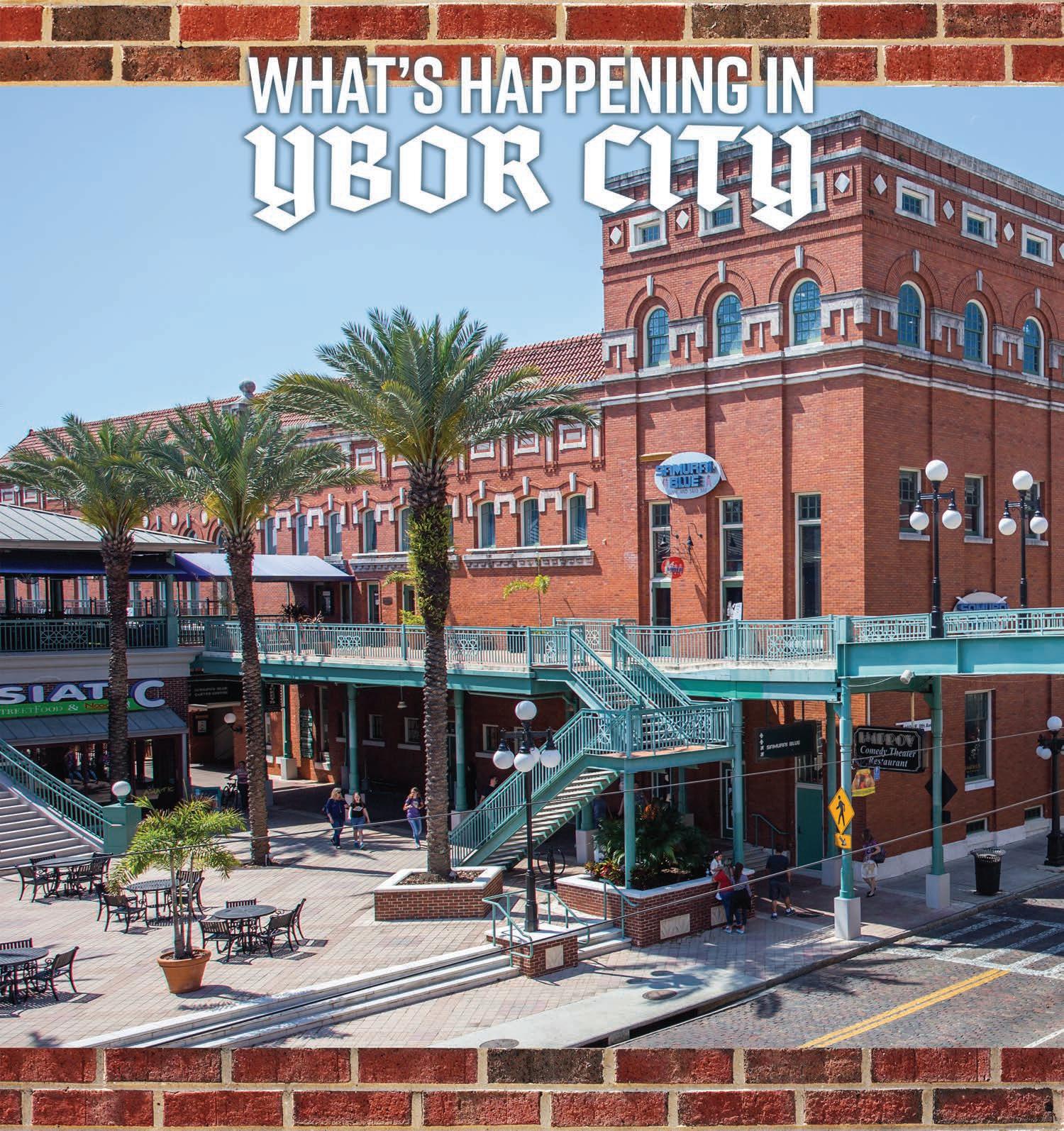



Friday, April 18, 2025 • 6:00 PM - 9:00 PM Tampa Bay Lightning Playoff Pop-Up @ Centro Ybor
1600 E 8th Ave, Tampa Open to the Public TampaBayLightning.com/Playoff PopUp
Friday, April 18, 2025 • Doors at 7PM, Show at 8PM FIRST TO ELEVEN w/ Brooke Surgener and the Bandits, Hello Sister @ Crowbar
1812 N 17th St Tampa
$20 - GA, $80 - VIP crowbarybor.com/calendar/#/events
Friday, April 18, 2025 • 10:00 PM - 2:45 AM
Gorgon City @ The Ritz Ybor
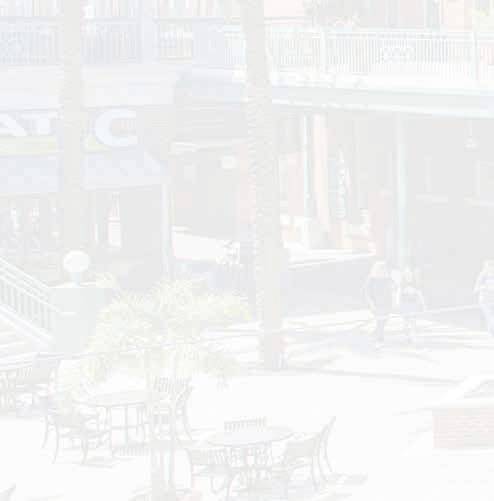
1503 E. 7th Ave – Tampa
$49 General Admission hive.co/l/gorgoncity0418
Friday, April 18 - 19, 2025
Doors at 6:15 PM, Show at 7:30 PM
Michael Blackson @ The Funny Bone
1600 E 8th Ave C-112, Tampa
Tickets start at $42 bit.ly/MBlacksonFunnyBone
Sunday, April 20, 2025 • 9:00 PM
Church Sessions ft. DJ Sandman & DJ Deacon @ Crowbar
1812 N 17th St Tampa
$5 Cover crowbarybor.com/calendar/#/events


Wednesday, April 23, 2025 • 5:00 PM - 8:00 PM
Ybor City Museum Wedding and Event Venue
Open House @ Ybor City Museum
2009 Angel Oliva Senior St. Tampa
Free to the public yborcitymuseum.com
Wednesday, April 23, 2025 • 6:30 PM - 8:30 PM
Bierzo Masterclass Wine Tasting with Master Sommelier Andy McNamara @ Chateau Cellars Ybor
2009 N. 22nd St. Tampa
$85 tickets bit.ly/BierzoYbor

Saturday, April 26, 2025 • 5:00 PM - 12:00 AM
TribeFest @ 1920 Ybor 1920 East 7th Avenue Tampa

Tickets start at $25 bit.ly/TribeFestYbor
Sunday, April 27, 2025 • 11:00 AM - 12:00 PM
Chicken Yoga with Yoga Loft Tampa and Ybor Misfits @ Hotel Haya 1412 East 7th Avenue Tampa
$12 General Admission bit.ly/ChickenYogaApril
Sunday, April 27, 2025 • 11:00 AM - 12:00 PM
Books & Brews @ Ybor City Coffee and Tea Co
1907 North 19th Street Tampa
Free to the public bit.ly/43YPyAk


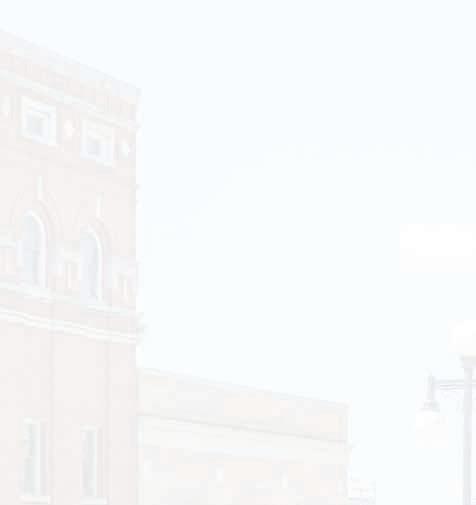
Tampa Bay Brewing Company 1600 East 8th Avenue, Tampa tbbc.beer/ybor-city
Jimmy’s Tacos 1604 N 17th St, Tampa jimmystacosfl .com
Los Chapos Tacos 951 E 7th Ave, Tampa loschapostacos.com
Barrio Tacos Tampa 1822 E 7th Ave, Tampa b arrio-tacos.com/locations/yborcity/
Rene’s Mexican Kitchen 2802 N 16th St, Tampa renesmexicankitchen.org/



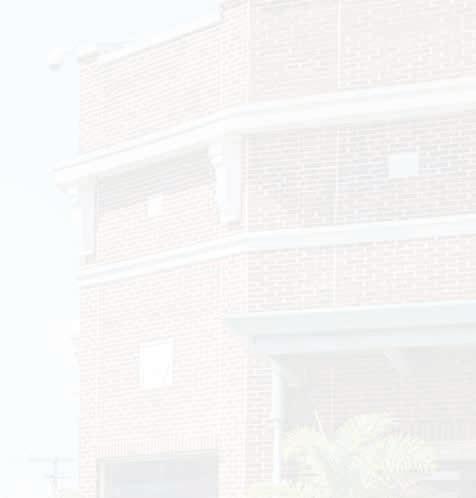
mic nights and upcoming shows! tampa.funnybone.com
Ybor City Saturday Market 1901 N. 19th Street Tampa ybormarket.com Sky Puppy Brewing 1313 E 8th Ave, Tampa

Casa Ybor
Casa Ybor offers unique retail spaces, office spaces, and apartment homes for rent or lease in both newly constructed and lovingly restored historic buildings throughout the vibrant National Historic Landmark District of Ybor City near Downtown Tampa, Florida. casaybor.com
La Union
Community, connection, and culture come together at La Unión Apartments, where Tampa’s rich history and vibrant future unite. Inspired by the historic social hall once on this site, our Ybor City apartments honor that legacy by fostering bonds among residents, the neighborhood, and the area’s deep-rooted heritage. bit.ly/LaUnionYbor

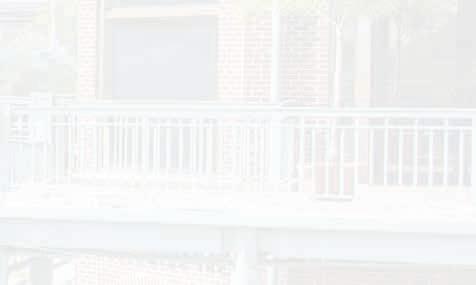
Check out local photographer Michael Johnson’s exhibit currently on display. New artist every month. New brews tapped & wines released every Friday skypuppybrewing.com










“I can’t wait to spray tan.”
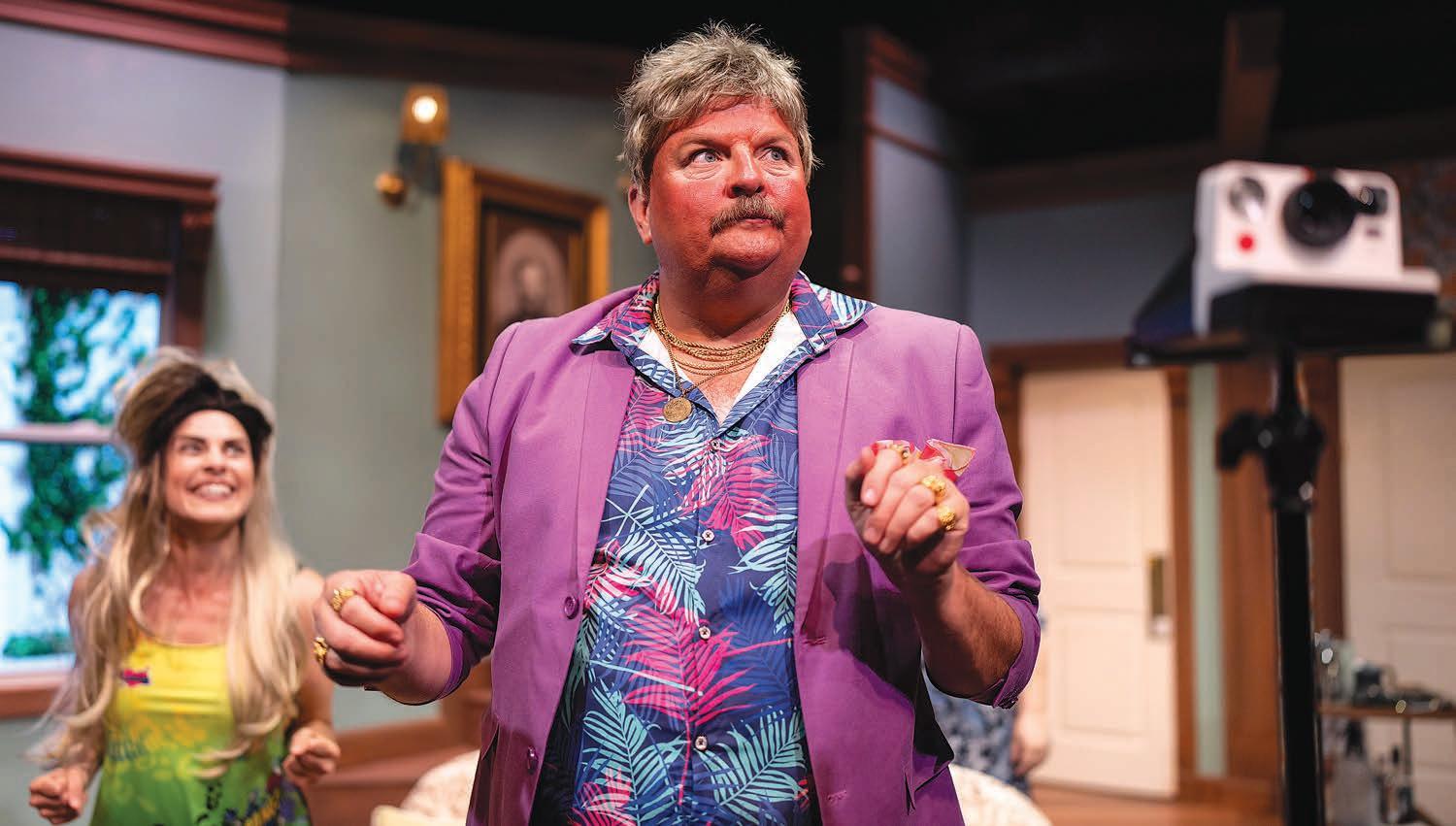
A new comedy at St. Pete’s freeFall Theatre, dives into the wackiness of small-town Florida.
By David Warner
There’s no issue in Florida that’s closer to, um, home than real estate—and none is more ripe for satire.
That’s what playwright Hannah Benitez is bringing us with “For Closure!,” which opened last weekend at freeFall. It centers on a pair of Realtors, Raven (Renata Eastlick) and Amanda (Sara DelBeato), who are trying to keep their agency afloat in the town of Gulfpalm. With the help of a flamboyant psychic (Matthew McGee), they set about to save an historic (and possibly haunted) building and fight the influence of a shady politico.
Matthew McGee? Flamboyant? Who woulda thunk? He chatted with Creative Loafing Tampa Bay recently along with fellow freeFall favorite Kelly Pekar and Producing Artistic Director Eric Davis, who’s directing the show.
McGee won’t be wearing drag this time out— at least, not female drag. For the role of Camille Chevalier Milk (which Benitez created with McGee in mind), he’ll be channeling camp icons
like comic DomDeluise, Puerto Rican astrologer Walter Mercado, and the bewigged and ever caftan-ated Rip Taylor.
So yes, there will be caftans. And wigs! DelBeato is an accomplished wig-maker as well as an actor, and she and McGee have been having a high time figuring out the right shade of garish for Camille’s coiffure(s).
“It’s been very funny, sending each other pictures and pictures of wigs,” says McGee. “I can’t wait to spray tan.”
He was also happy to discover that he gets to spend part of the show on a mobility scooter, meaning perhaps that the 50-year-old actor could continue playing Camille into his senior citizen years. (Benitez has already received interest in her script from theaters in Florida and Michigan and from commercial producers.)
Kelly Pekar, who now lives in Brooklyn, New York, remains one of freeFall’s most beloved performers, known first as an ingénue in roles like Cinderella in “Into the Woods” and Clara in
“The Light in the Piazza.” It wasn’t until Davis asked her to play multiple roles in the company’s first Sherlock Holmes romp, “Baskerville,” that we saw her versatility in full flower, playing a whirlwind of male and female roles with comic panache.
In “For Closure!,” she’s again getting the chance to play multiple characters, including an exotic dancer determined to unionize area strippers, an eccentric bird lady, an oligarch’s wife, and the trophy wife of a local politician.
Pekar and Benitez met in 2016 in freeFall’s production of “Mr. Burns—A Post-electric Play.” (Benitez has been in six freeFall shows in all.) Since then, the two have collaborated on numerous projects, including Benitez’s “Dike,” which was rapturously reviewed at Sarasota’s Urbanite Theater in 2018, the first of her plays to be produced in our area.
a willingness to collaborate which has made the process of working on “For Closure!” a pleasure, says Pekar.
McGee agrees. “I feel most at home comedically in many ways with Hannah. We think the same things are funny, so that has been a joy. And honestly, for some actors it might be nerve-racking, but she’s in there with Eric and we’re changing material and jokes on the fly, like little tweaks, and it’s just so much fun.”
For Closure!
As cast and crew move onto the set, they’ll test what Davis calls “the practicalities” of the script— which, like any classic farce, involves doors, many doors.
Wednesdays-Sundays through May 11. $25 & up. freeFall Theatre, 6099 Central Ave. St. Petersburg. freefalltheatre.com
“People running in and out of rooms to be heard by certain people and not by other people—all the things that happen in farce—are present in this,” he says.
Davis has long been a fan of Benitez’s talents as a writer as well as an actor, and when she approached him about her wish to do a comedy, he was all about it. Though farce is not the genre she’s most known for, Benitez brings a mastery of playwriting structure along with
McGee (who is also freeFall’s marketing and communications director) references “Poltergeist,” “The Birdcage,” even “Arsenic and Old Lace” when describing “For Closure!”—all enticing antecedents.
Most appealing of all: Benitez’s characters are “completely off their rockers.”
Which sounds like the world of Florida real estate, all right.

























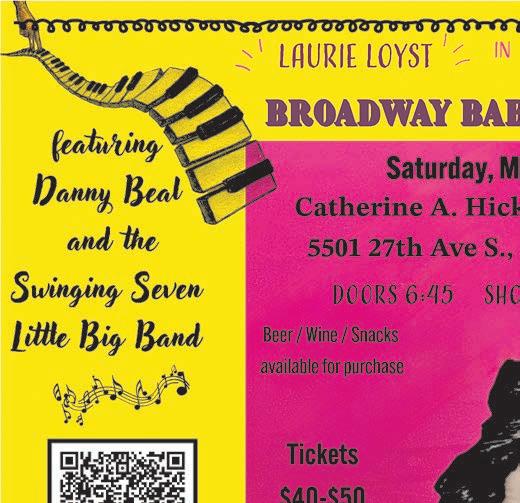





SUNDAY, APRIL 27 | 2-3 PM
The Western fascination with kimono continues in the twenty-first century. In this presentation, we examine where the line is drawn between appreciation and appropriation, and compare and contrast different viewpoints between JapaneseAmericans and native Japanese who were born and bred in Japan.

THU APRIL 17–WED APRIL 23
C Slothrust w/Bad Bad Things Will Gorin’s favorite quote comes from Miles Davis’ biography: “Music is the space between the notes.” “I approach my playing with that kind of energy, with an emphasis on filling negative space with symmetrical or asymmetrical patterns,” Gorin, drummer for Boston rock band Slothrust, wrote in a press release. Composed of the multi-talented Leah Wellbaum and Gornin, Slothrust offers an alternative/indie rock sound that features poetic lyrics and guitar solos that are simultaneously chaotic and melodic. Slothrust was supposed to play Tampa last month to celebrate the 11-year anniversary of its breakout album Of Course You Do , but postponed the show due to the widespread effects of the California wildfires. Previously purchased tickets will be honored for the new date. (Crowbar, Ybor City)—Grace Stoler
Chulismo w/Arcane Arcade/Lot Lizards/ Pig Pen If you’ve ever felt nervous being followed in your car by the cops, there’s a song for that. St. Petersburg trio Chulismo plays classic, Ramones-era chugging punk-rock, and brings its debut single “D.U.I.” to this no-cover arcade gig. (The Potion Portal, St. Petersburg)
Genitorturers w/Rorschach Test Last year was one of justice and new beginnings for Rorschach Test. Following years of radio silence, the Denver-bred industrial metal band reemerged with a new lineup (still including frontman James Baker), its first new album since the Clinton administration, and the copyright to its sophomore album Unclean back home. Things have changed for sure, but if this opening set for hometown hero Genitorturers sounds anything like the band’s 2024 release Fallen, it’ll be like no time has passed at all.(Brass Mug, Tampa)
Jerk Dog Records Birthday Crash: Las Nadas w/Last Bias/Fisherpriceguillotine/ Doug Burns Jen Kokay—who works at the Bradenton record shop with The Cramps’ Lux Interior painted on the, err, exterior—has been indulging in what feels like an impossible challenge of spinning every single album she has collected over the years. Kokay says that she’ll cap that collection once she reached 1,600, but we can only hope that if local punk outfit Last Bias is selling any hot-off-the-presses copies of its new album The Sea Hates A Coward (one month old and instrumentally one of the best punk albums of the year) at the store’s 11th birthday party. (Oscura, Bradenton)
Justin Hayward w/Mike Dawes One of the sole surviving Moody Blues makes a point to swing into the historic downtown Clearwater room every year. In between a few stories about his life and late friends, Hayward performs stripped-down versions of the progressive rock anthems and hits that got him inducted into the Rock and Roll Hall of Fame in 2018, including a version of “I Know You’re Out There Somewhere,” which might be superior to the original late ‘80s recording of the sentimental look at the past. Guitar whiz Mike Dawes—who plays in the 78-year-old’s band—opens. Ahead of this show, Hayward told Creative Loafing Tampa Bay about the best gig he ever saw turning him onto the Gibson 335 guitar that would later become his go-to axe. Read his full quote at cltampa.com/music. (Bilheimer Capitol Theatre, Clearwater)

C Khruangbin w/Helado Negro Known for its wiggy aesthetic and genre-defying instrumental sound that travels between funk, psych-rock and even disco, Khruangbin last played locally in 2022 and is adored in both indie-rock and jam scene circles. Its new album, A La Sala (stylized in all-caps), even features ‘60s Brazilian MPB vibes. Floridaborn experimental Latin-folk producer Roberto Carlos Lange, aka Helado Negro, opens the shows in support of his own 2024 album Phasor. The Khruangbin booking is yet another score for local live music lovers that might’ve never come to fruition without the Sound. The venue, which opened in 2023, can accommodate 4,000 people under cover and another 5,000 on its lawn.
An act like Khruangbin (a Thai word for “airplane” pronounced “k-rung-bin”) that’s outgrown large clubs but not yet graduated into arenas might’ve skipped over our neck of the woods had a venue with BayCare Sound’s seating capacity not opened. (The BayCare Sound, Clearwater)
C Pusha Preme EP Release Tampa rapper Pusha Preme wears a mask to protect the privacy of his family, but the veil is always drawn back in his music. “It’s not just about
breakups—it’s about the moments that cracked me open and forced me to grow,” he told CL about his new EP, Sum Hearts R Meant 2B Broken (stylized in all-caps). “The project lives in that space between pain and power, where you learn to love yourself after losing what (or who) you thought you needed.” Sonically, the record finds Preme in between the Afrobeat of recent work and bringing in alt-R&B influences, and he plays it all live at this Seminole Heights release show. (Velvet Gypsy, Tampa)
C Stripes w/Movie Props/The Venus/ Willie Jones Cocktail Hour Suite E Studios continues its emergence as a reliable venue for live, original music, and welcomes Brooklyn indie-rock band Stripes. Fresh off the release of a melancholy spring single, “Always Late” (stylized in all-lowercase), Stripes can also turn up the fuzz and jangle on songs like the catchy “Forever, It Won’t Change” and “Sharp Knife.” Psych-rock band The Venus makes a rare appearance as part of a solid trio of homegrown openers. (Suite E Studios, St. Petersburg)
C Tommy Prine w/Matthew Fowler The nonprofit inspired by his father’s music just spent the weekend in Tampa Bay for benefit concerts, and now Tommy Prine (the son of the late John Prine and his widow Fiona) is in town to share his voice. Released last summer, the 29-year-old’s debut full-length This Far South draws from a collection of private songs that catalog the triumphs and tragedies of his life. And while you can hear some of his father in the delivery, don’t expect a set of John Prine Jr. music as Tommy is certainly carving out a land for himself in a perpetually-crowded singer-songwriter scene. (Skipper’s Smokehouse, Tampa)
DJ Pauly D w/Sidequest Cabs ah heeeeaaah! The most crushed-on “Jersey Shore” cast member is back in Tampa for another DJ set. Yes, he’s still got the same hair. Yes, he’s still hot. DJ duo Sidequest, which just played a set airboating through a swamp, opens. It’s a busy weekend of untz for the Cuban Club, too, with U.K. producer James Hype set to play the night before. (Cuban Club, Ybor City)—Selene San Felice
Busch Gardens Food & Wine Festival: Plain White T’s If you’re stuck holding the bags while your group is riding rollercoasters this weekend, there’s only 1 thing 2 do: see that band that did “Hey There Delilah.” The pop-rock band dominated the charts with that song and others like “1, 2, 3, 4” and “Rhythm of Love” in the 2000s. With lead singer Tom Higgenson as the last founding member, the T’s released a selftitled studio album in 2003 and covered “Surface Pressure” from “Encanto” for a Disney pop punk cover album last year. If you miss the band at Busch Gardens, it’ll be in Orlando in November for the revamped Vans Warped Tour with other Hot Topic favs. (Busch Gardens Tampa Bay, Tampa)—SSF
C Traitors w/Crown Magnetar/Yosemite In Black/Thirst/Think Twice Everyone has their tolerance levels, but if you’re planning on dancing with Mary Jane this 4/20, it might be best to avoid the latest music video from Traitors, a deathcore outfit with direct connections to Tampa. Ahead of releasing its new album Phobias , the 12-year-old group paired lead single “No Witnesses” with a static, multicolored video that could very well cause your eyes to need some rest. (Orpheum, Tampa)
Mayday Parade w/Microwave/ Grayscale/Like Rose Last summer, Mayday Parade’s Alex Garcia told CL Tampa that his band was working on new material, but didn’t necessarily want to put everything out in bulk. But once it hit that the Tallahassee five-piece was turning 20 this year, minds must have changed because in January, Garcia and friends announced a trilogy of releases to celebrate their China anniversary together. The first album Sweet , which releases days before this return to town, is set to feature Knuckle Puck, and a few songs about how a relationship, regardless of its current status, saw the narrator work on bettering himself. (Jannus Live, St. Petersburg)
C Todd Rundgren If you’ve seen classic rock’s most eccentric unicorn live multiple times (Bowie was a chameleon, thank you very much), you probably remember at least one moment of significance per show. Whether Rundgren was performing “Butter on a Pop Tart” with Daryl Hall sitting backstage, or performing his album A Wizard, A True Star in its entirety, the next trick up his sleeve will see him at the forefront of a traveling tribute to songwriting legend Burt Bacharach, who died in 2023. The 76-yearold is joined onstage by Bacharach musical director Rob Shirakbari and “The Voice” runner-up Wendy Moten. (Mahaffey Theater, St. Petersburg)
C Napalm Death w/The Melvins/ Weedeater The current iteration of the pioneering death metal outfit brings a career retrospective spanning over 45 years back to Tampa for the first time in three years. The Melvins—who have toured with Napalm Death as far back as 2016—will have two drummers, Dale Crover and Coady Willis of Big Business, in tow, as well as ganjametal group Weedeater playing opener. Eat your heart out, Cannabis Corpse. (Orpheum, Tampa).
See an extended version of this listing via cltampa.com/music.




After seeing the band in an air-conditioned arena two summers ago, Bay area Blink-182 (stylized “blink-182”) fans are really gonna have to take off their jackets for the band’s next local gig. The pop-punk/dick joke elder statesman announced a new tour last week, including two kickoff dates in Florida.
The “Missionary Impossible” run, which wraps in October at Las Vegas’ When We Were Young Festival, comes on the heels of Blink-182’s latest album, One More Time…, which marked the first collection of new, studio-recorded songs by the trio of Mark Hoppus, Tom DeLonge, and Travis Barker.
A press release says, “The upcoming shows will lean into blink-182’s punk roots, with a setlist packed with classics spanning their
Hed PE Saturday, Aug. 23. 6:30 p.m. $18. Brass Mug, Tampa
George Thorogood & The Destroyers w/Artimus Pyle Band Sunday, Aug. 31. 7:30 p.m. $44.25 & up. Ruth Eckerd Hall, Clearwater
Astropical Sunday, Aug. 24. 7 p.m. $59.50 & up. The BayCare Sound, Clearwater
Michael Schenker Sunday, Sept. 7. 8 p.m. $39.50 & up. Bilheimer Capitol Theatre, Clearwater
Garbage w/Starcrawler Saturday, Sept. 6. 8 p.m. Prices TBA. Jannus Live, St. Petersburg
Pink Turns Blue w/Some Days Are Darker Saturday, Sept. 13. 7 p.m. $22. Music Hall at New World Brewery, Tampa
RuPaul’s Drag Race Saturday, Sept. 13. 8 p.m. $38.25 & up. Ruth Eckerd Hall, Clearwater
entire catalog.” The only other Florida date is the kickoff gig on Aug. 28 at Hard Rock Live in Hollywood. Alkaline Trio opens all shows.
Blink-182’s last local show was a grand reunion of sorts where Hoppus couldn’t help but make jokes that made a generation of teenagers laugh back in the late ‘90s. “There is so much sexual tension up here,” Hoppus told a crowd of about 18,000 at Amalie Arena.
All-in tickets to see Blink-182 play MidFlorida Credit Union Amphitheatre in Tampa on Friday, Aug. 29 are on sale now starting at $67.20. See Josh Bradley’s weekly rundown of new concerts coming to Tampa Bay below.—Ray Roa
Leon Bridges w/Charley Crockett/ Reyna Tropical Monday, Sept. 15. 6 p.m. $40.50 & up. The BayCare Sound, Clearwater
Noga Erez w/V1v1d Friday, Oct. 3. 8:30 p.m. $26. Jannus Live, St. Petersburg
Crowder w/Passion/Louie Giglio/Kari Jobe/Cody Carnes Saturday, Oct. 4. 7 p.m. $15 & up. Yuengling Center, Tampa
Matt Maltese Tuesday, Nov. 4. 8 p.m. $32. The Ritz, Ybor City
Everclear w/Local H/Sponge Wednesday, Oct. 8. 7:30 p.m. $56 & up. Bilheimer Capitol Theatre, Clearwater
Automelodi w/Glass Chapel/DJ Winters Saturday, Oct. 18. 7 p.m. $17. Music Hall at New World Brewery, Tampa
Sting Monday, Nov. 10. 8 p.m. $564 & up. Hard Rock Event Center at Seminole Hard Rock Hotel and Casino, Tampa
























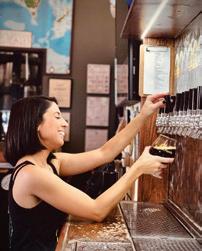
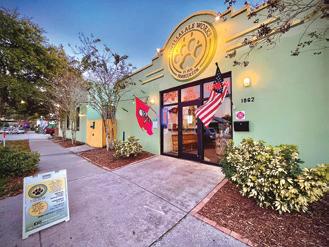



It’s next to nothing
Bambi’s journal?
Mall store that caters to wildebeest owners?
Sword handles
Roast, on le
Lose, as pounds
Magazine for neophyte needlepointers?

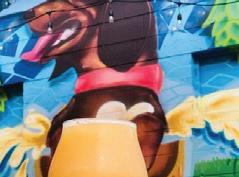


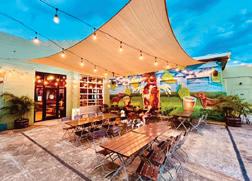





Out on one’s
Tussaud
Plant with myriad
that
Dien Bien ___, Vietnam
















